College and UGSDW disagree about Union newsletter distribution practices
By Nina Baker bakernin@grinnell.eduThe Union of Grinnell Student Dining Workers (UGSDW) has alleged that Grinnell College’s practice of removing UGSDW

Worker Power newsletters from some campus spaces violates the National Labor Relations Act (NLRA). Yet, according to members of the College administration, the distribution of UGSDW newsletters not only violates the College’s Advertising/Signs/
Tabling Policy, but also conflicts with the 2021-23 collective bargaining agreement between the College and UGSDW.
After a historic election last spring, where the Union expanded to include all hourly student workers,
UGSDW began the 2022-23 academic year with a push to include as much input from student workers in collective bargaining negotiations as possible, which included distributing newsletters under the title Worker Power, according to former UGSDW
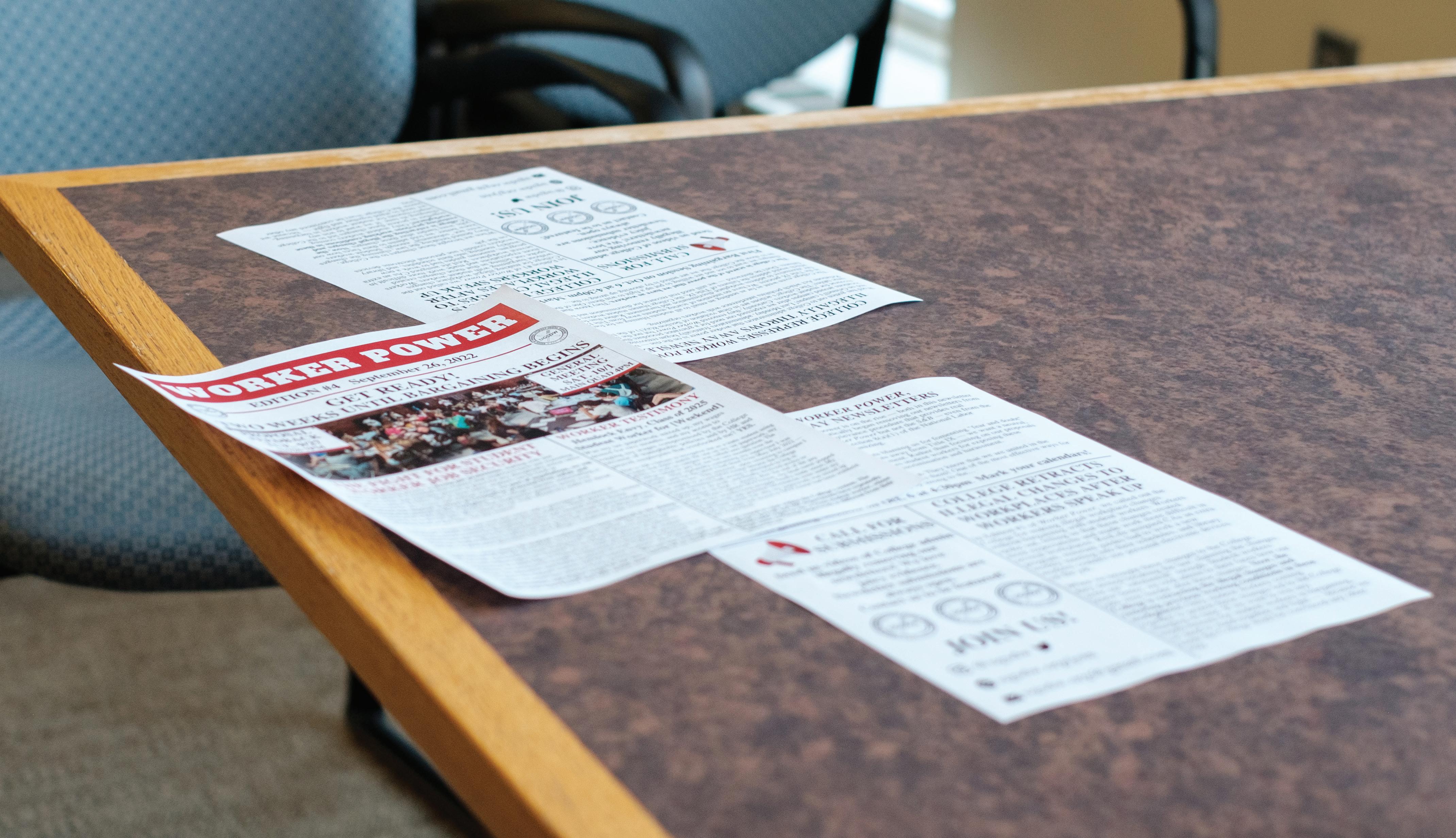
President Keir Hichens `22.5 The distributed newsletters have been removed from tables in the Spencer Grill by non-student staff
College rejects UGSDW accusations of federal labor rights violation
By Ellianna Cierpiot cierpiot@grinnell.eduThe Union of Grinnell Student Dining Workers (UGSDW) accused Grinnell College of a federal labor rights violation, a claim the College has rejected as a misrepresentation of existing workplace expectations.
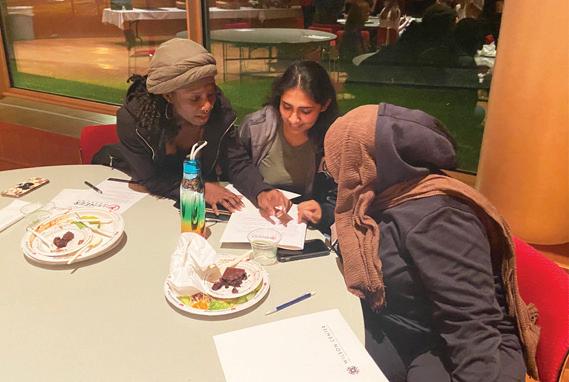
These claims were made on the UGSDW’s website and in the Sept. 5 and 13 editions of the Worker Power newsletter distributed around campus.
UGSDW alleged that changes were made to the employment agreement of Burling Library workers and Community Advisors (CAs), which they say is a violation of the National Labor Act of 1935.
This law states that an employer cannot make a unilateral change to the workplace when engaging in bargaining with a recognized union, or in the stages before engaging in bargaining, unless these changes are minor.
According to the UGSDW newsletter and Executive Board Member at Large Malcolm GalpernLevin `24, the alleged change to the library workplace involves an agreement that library workers had to sign which indicates that they will not use personal technology while on their shift.

Although library student workers signed the agreement this semester, the expectation that library workers do not use their own technology at work was already in the library workers’ handbook, according to Grinnell’s Vice President for Communications Ellen de Graffenreid.
According to de Graffenreid, the alleged violation of bargaining law did not take place because no change to employment expectations occurred.
UGSDW has also alleged that the work requirements for Community Advisors (CAs) have increased compared to the previous semester’s requirements. CAs were voluntarily recognized into UGSDW in August 2022 by the College.
Sira Nassoko `24, a CA in Cowles, said that she has noticed an increase in

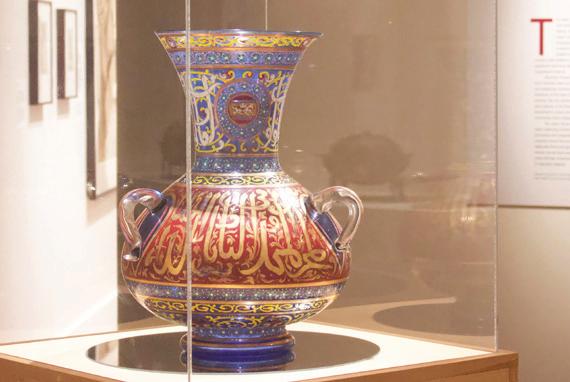

programming requirements since her time working as a CA during the 202122 school year.
The initial programming requirements outlined in the bargaining contract were two total “active programs” in a semester. Nassoko alleged that this was changed during training week to be three total programs, and the expectations for what the programs would entail have also changed to be more intensive.
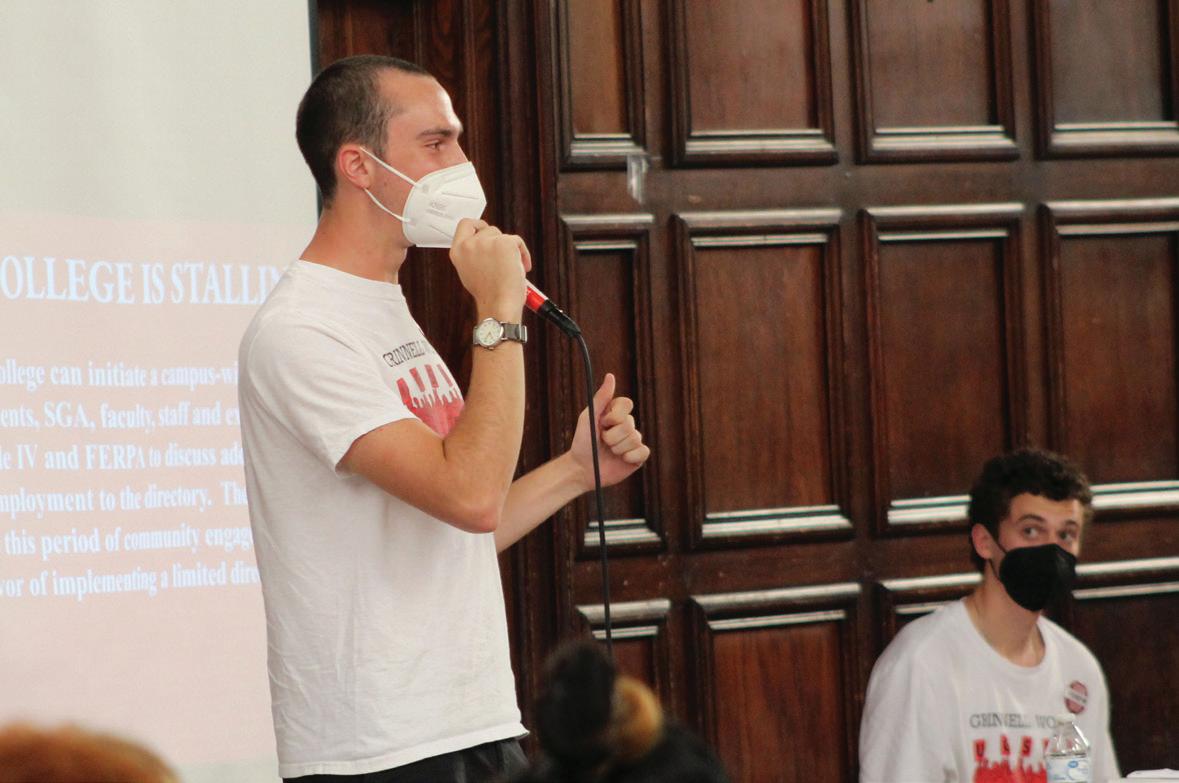
Nassoko also noticed an additional workload increase in requirements for sociograms, which are check-ins with residents that CAs are expected to do. This year, she said, there is an expectation to have a 15-minute check-in with each resident, which differs from the previous year.
The College disputes the Union’s allegations, and according to de Graffenreid, no changes to the CA work requirements occurred.
“Existing work rules were reworded and reordered for enhanced clarity and advice for remaining healthy was included. No workplace changes occurred in either example,” de Graffenreid wrote in an email to the S&B. “The College is committed to investigating any additional examples that UGSDW wishes to bring forward.”
Nassoko said she thinks this is an unfair representation of what happened.
“They sprung it on us during training, I don’t think it’s fair to say that it was just reorganized when we had no idea that that was gonna be expected of us until the week of training,” Nassoko said.
In the first issue of their newsletter, distributed on Sept. 5, UGSDW also accused the College of violating bargaining terms by withholding data about student workers on campus.

“Grinnell College has refused to provide UGSDW with a list of student workers by workplace. Every union is guaranteed this information under the National Labor Relations Act of 1935,” the first issue of the Worker Power newsletter states. “The College wants to make it as hard as possible for
us to represent every student worker!”
This is a claim that the College said is a misrepresentation of the situation. Since Grinnell College is a private educational institution, the administration must follow the Family Educational Rights and Privacy Act (FERPA), which prohibits the disclosure of the information that the Union is requesting. However, as the employer in a bargaining stage with a recognized union, Grinnell College is also beholden to the National Labor Relations Act (NLRA).
“The intersection of FERPA and the NLRA — and which set of laws governs this request — is an area that is still unclear,” de Graffenreid wrote.
protected student employment data,” de Graffenreid wrote. “The College is committed to transparency in how student data and private information is handled and disclosed to third parties and will not disclose protected data to the Union without student consent.”
UGSDW does not intend to file an unfair labor practice charge, according to Isaiah Gutman `23, UGSDW President. However, he said that UGSDW wants the College to cease making the alleged changes to the student workers’ contracts and communicate with UGSDW going forward.
“The College and Union agree that no unilateral changes to wages, hours,
De Graffenreid also wrote that the College has proposed two alternate solutions to the Union: an opt-in FERPA release waiver or a campuswide education initiative to discuss adding employment information to the directory. If employment information became a field in the directory, it would be able to be shared without violating FERPA’s information release prohibitions. However, directory information can only be disclosed if the institution informs students that their employment information would be disclosed.
“In each case the Union has refused the College’s proposed solutions and demanded the immediate release of
terms and conditions of employment can occur until all parties come to the collective bargaining table,” de Graffenreid wrote. “The College continues to work with supervisors through training, communication and sharing of best practices to ensure these changes do not occur.”
Editor’s Note: Isaiah Gutman is the Sports Editor for the S&B. Gutman was not involved in the writing or editing of this article.
As student workers, all staff members of the S&B will be included in future collective bargaining. The S&B remains an independent newspaper and is committed to maintaining its integrity in reporting.
Sports: Women’s golf enters national rankings Arts: “Reverent Ornament” spans nations, centuries outlines EVAN HEIN The Union of Grinnell Student Dining Workers has been distributing their weekly newsletter, Worker Power, since the first week of September 2022. The newsletters have been removed in what the Union has alleged is a violation of the National Labor Relations Act; the College has alleged the method of distribution of the newsletters violates both the College’s own Advertising/ Signs/Tabling Policy and the current 2021-23 collective bargaining agreement between UGSDW and the College. MADDI SHINALL Former UGSDW President Keir Hichens `22.5 spoke at the Union Kickoff Event on Aug. 27.Working Differently Days to return in the spring
Students win thousands for project proposals in Pioneer Weekend
By Jane Hoffman hoffmanj@grinnell.eduThe Joe Rosenfield Center was once again transformed into a project incubator as students worked late into the night identifying problems, brainstorming solutions and refining their deliveries during the Pioneer Weekend, an annual three-day innovation and pitch competition organized by the Wilson Center for Leadership and Innovation.
judges, who asked questions about legal considerations, profitability and employment structuring.
The judges assessed each product’s design, innovative qualities and the degree to which it responded to the chosen problem. Each team was scored on their business plan and presentation quality. Teams also received a “social innovation” bonus if the product advanced a societal good.
By Marcy Cassidy cassidym@grinnell.eduThis past summer, the Grinnell College Office of the Dean released a statement announcing that Working Differently Days are postponed until the spring semester of 2023. The decision to postpone them in the fall semester of 2022 resulted from Beronda Montgomery’s, dean of the College, review of feedback from several on-campus committees and survey data from psychology major Nameera Dawood `23.
In the spring semester of 2022, Working Differently Days were introduced by Elaine Marzluff, former interim dean of the College, and Anne Harris, president of the College. The stated goal was to address the impacts of the COVID-19 pandemic on students and to provide students with opportunities for selfguided learning by taking a physical pause during the semester.
“I did get feedback from both staff and students that there was an interest in understanding the intentionality around Working Differently Days. The feedback that I got was that many people wanted to see them continue,” Montgomery said.
Montgomery had several conversations with faculty, staff and students across the Student Government Association, Staff Council and Committee on Academic Standing when evaluating the status of Working Differently Days.
The Committee of Academic Standing specifically makes recommendations for the academic calendar, and they helped to choose the dates for this year’s Working Differently Days based on different factors including the dates’s relation to spring break and the specific day of the week.
Student feedback also came as a report from Nameera Dawood, who conducted a survey of the Grinnell College student body to indicate student trends on how they spent their Working Differently Days.
“Grinnell always has such an intense workload that the opportunity
to slow down or change pace allowed for a healthier balance in my academic schedule,” said Marina Busby `24. “ I just know the lack of those few Working Differently Days has already made looking ahead in the semester more stressful for myself.”
According to Montgomery, there were concerns among faculty regarding implementation and prior notice. Without ample notice, professors would not be able to adjust for newly canceled classes, offsetting syllabi and forcing certain classes to use their Working Differently Days as independent class periods.
The annual Pioneer Weekend offers students the chance to win thousands of dollars and “stretch their entrepreneurial muscles,” according to Kerty Levy, one of this year’s judges. Levy is the managing director of Techstars Iowa, a startup accelerator program that offers mentorship and resources to its portfolio of companies.
The judge’s panel at this year’s event, which began on Friday, Sept. 23, also featured Alexander McLean and Jana Grimes. McLean is a lawyer and activist who founded Justice Defenders, a nonprofit organization that provides legal training to prisoners and prison staff in Gambia, Kenya and Uganda, and was the 2020 recipient of the Grinnell College Innovator for Social Justice Prize (Grinnell Prize). Grimes is the vice president of human resources at Grinnell College.
As part of the competition, students were supported by a group of alumni and local mentors who provided feedback and advice during the planning stage of the weekend. This year, Steve Elkes `83, Barb Baker, Terri Brady `79 and Leigh Kunkel `09 served as mentors.
After a period of deliberation, the judges announced the 2022 slate of winners.
“The Demolition Room” came in third place and each student received $150. Operating on the premise that Grinnell has a dearth of substance-free entertainment beyond campus, Evaan Ahmed `23, Katie Babb `26, Timur Kasimov `25 and Paata Kaloiani `25 pitched their project: a “demolition room” where individuals could smash and destroy furniture and trinkets that might otherwise be discarded, for stress relief and entertainment.
Nameera Muhammad Dawood `23, Nhật-Hồng Doan `24, Sneha Lohani `23, Elias Lawler `23 and Ganga Prakash `25 received the second place award and $300 each for their “Open Town” proposal. The proposed project would help close pandemic-induced achievement gaps in reading and math skills in Grinnell’s public schools, and it would provide both educational assistance and mentorship opportunities with the college.
The first place winners, receiving $500 each, Diego
Rodrigues `25, Vinicius Ono Sant`anna `24, David Dai `23, Enzo Pereira da Cunha `26 and Trung Le `25 proposed “Spaced.” “Spaced” is an app that connects students in need of summer storage with town residents that have extra room. In their pitch, the group highlighted how this “decentralized” model would make summer storage more affordable for students, profitable for individuals with extra space and beneficial for students and residents in Grinnell.
After the awards ceremony, Dai said the team was “honored and humbled” to receive the first-place award and that they enjoyed working alongside so many talented teams over the course of the weekend.
“We’re excited and encouraged to put this into practice,” said Ono Sant’anna, who worked on the “Spaced” pitch. “We’re definitely not stopping here.”
Union
In his concluding remarks, Wilson Center Director and mathematics professor Jeff Blanchard said that while only three teams received monetary awards, all participants would derive long-term benefit from their hard work over the course of the weekend in their classes, careers and other endeavors.
The decision to postpone Working Differently Days this semester came from a desire to effectively address these concerns and make sure faculty were able to mutually benefit from the system, and the number of days were reduced from three to two in order to adjust for spring break.
“I had to ask whether I was going to recommend the implementation of them late in the summer as faculty were already preparing their syllabi,” Montgomery said. “I wanted to ask questions about whether their implementation was adequately considering the impact on staff and whether staff were able to fully engage in working differently days.”
In the spring semester of 2023, the Working Differently Days will be scheduled for Thursday, March 2 and Wednesday, April 26; the targets for fall 2023 are Sept. 27 and Nov.
7. Presently, Montgomery said she is unsure if these dates will be subject to change moving forward.
Students prototyped and shared digital and analog solutions to problems they identified in the community or world at large — often highlighting the social impact that their projects would have on users and the surrounding community.
The six groups sought to address a diversity of problems ranging from the frustrations of trying to find summer storage spaces in Grinnell to building a safe and economical alternative to ethanol stoves in Brazil.
After a keynote address from Elkes on Friday evening, participants began brainstorming and pitching ideas to each other before narrowing down their projects and splitting into formal teams.
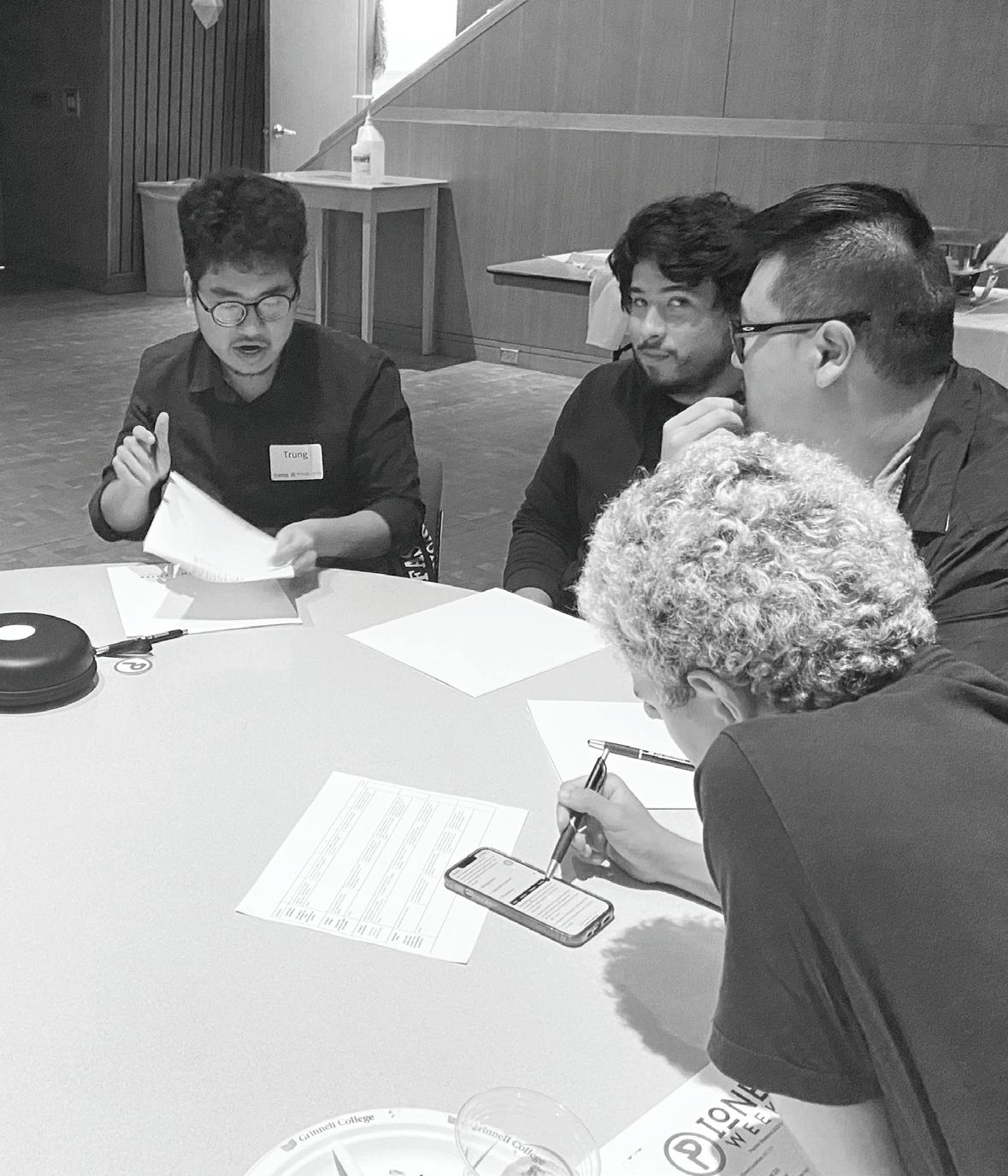
From 8 a.m. to 11 p.m. on Saturday, the teams refined their plans, built out prototypes and bounced ideas off their advisors during a series of mentor sessions.
On Sunday, each group had 10 minutes to pitch their prototypes, business plans and the estimated impact of their projects to the
College and UGSDW in postering dispute
from
members. Mattia Wells, senior content strategist, cited both the current collective bargaining agreement and the College’s postering policy as reasoning for the removal of the newsletters.
In an email to the S&B, Wells wrote that during prior conversations between UGSDW and the College, both parties agreed to honor the 202123 Collective Bargaining Agreement, which can be viewed online at UGSDW’s website. Wells listed Section 3.5, where the agreement reads: “The Union agrees it will not engage in general distribution, or posting by employees, of pamphlets, advertising or political matters.”
Hichens declined to comment on Wells’ allegation that the current bargaining agreement placed limits on UGSDW’s ability to distribute newsletters and that members of the administration did not mention the alleged violation of the collective bargaining agreement during their joint meetings in the past month. He said it was only brought up in an email to UGSDW after the meetings.
Hichens did comment, however, that the current contract only applies to student employees covered under the original contract, which includes student workers employed by Grinnell College Dining Services, rather than all student employees at the College.
Although the College recognized the Union’s newsletter distribution as inconsistent with Section 3.5 of
the current collective bargaining agreement, Wells wrote that after multiple meetings with members of UGSDW, “College administration made the decision to remove only fliers that were posted in a manner inconsistent with the Advertising/ Signs/Tabling policy.”
The College’s poster policy states that, “Free postering is limited to College-owned residential spaces and in the JRC outside the dining hall … Any postings/flyers placed in areas outside of these designated locations (e.g., windows, doors … on tables/ desks) ... will be removed by College staff.”
Wells wrote that the College’s “actions to date have allowed more posting access to the union than the contract stipulates.”
and engage in collective bargaining.
NLRA Section 8(a)(1) states that unfair labor practices by employers include interfering with, restraining or coercing employees in the exercise of rights guaranteed in Section 7 of the NLRA. Among other rights listed in that section, employees have the right to engage in “concerted activities for the purpose of collective bargaining or other mutual aid or protection.” According to the NLRB website, these rights include the right to distribute union literature.
“They don’t want student workers to read what is in these newsletters. They don’t want us to present a unified front and they don’t want people to get ready to take action,” Hichens said.
Wells wrote that “Grinnell College does not agree with the Union’s contention that these actions are in violation of Section 8(1)(a) of the National Labor Relations Act.”
last year. But as collective bargaining negotiations near, Wiebe said she became increasingly engaged with supporting UGSDW.
other student materials — namely, the print edition of the S&B — had not been removed, despite being placed on the same tables.
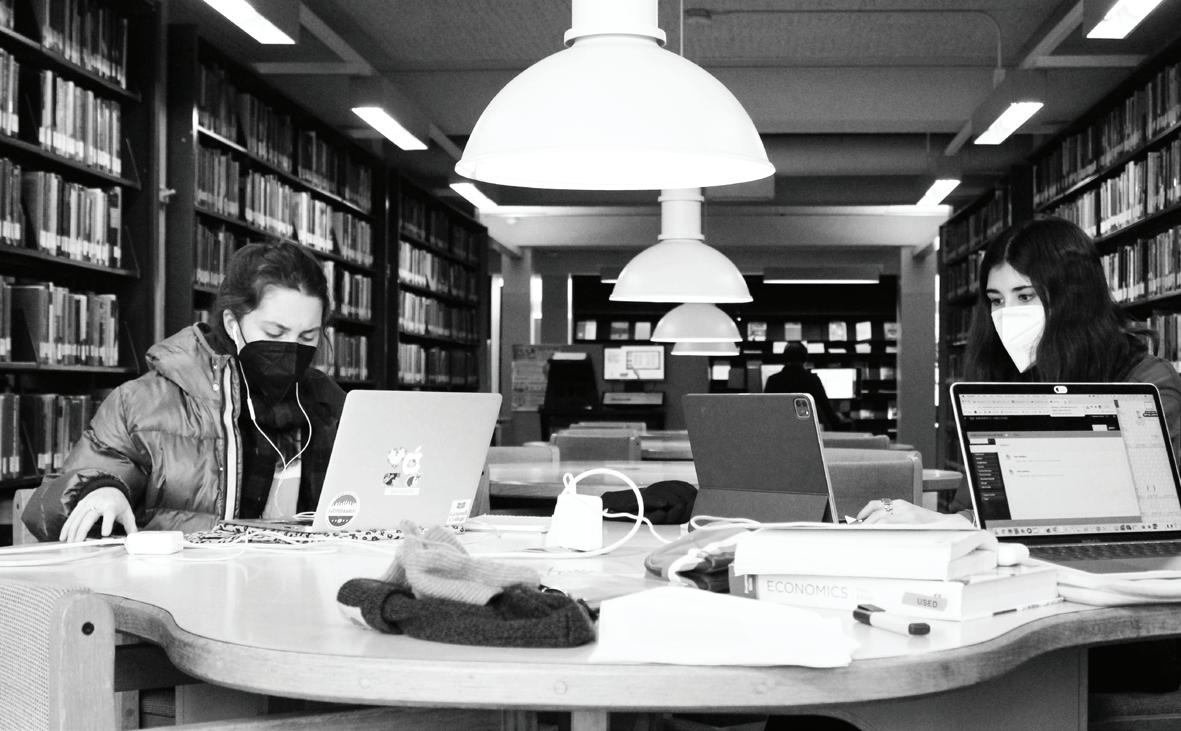
Wiebe alleged that the supervisor responded that UGSDW newsletters were different from the S&B print edition and that the S&B newspapers did not have an agenda.
Wiebe said she continued to distribute the newsletters anyway. Throughout Monday, Wiebe alleged that supervisors and members of the College administration continued to remove newsletters from the Grill.
“We’ve gone in and replaced them, like five separate times,” Weibe said. “This has happened in various places throughout campus.”
“I knew what the Union’s priorities were, and I knew that they lined up with mine,” she said. Over the past two weeks, Wiebe said she has helped to distribute Worker Power newsletters on Monday mornings.
Hichens said he believes the College’s decision to remove the newsletters is based on the content of the newsletter, rather than the advertising policy.
In the Sept. 26 edition of the newsletter, the Union alleged that the practice of removing flyers violates Section 8(a)(1) of the National Labor Relations Act (NLRA), which sets federal standards for the rights of employees to organize into unions
Hichens also said that the removal of UGSDW newsletters but not print editions of the Scarlet & Black is a “blatantly discriminatory” practice that he thinks is based on content differences between the two publications.
Wells wrote that the S&B “is materially different from UGSDW” because the S&B is an officially recognized College newspaper and a recognized student organization.
Lena Wiebe `25 helped distribute Worker Power newsletters. She said she has held multiple campus jobs at the College, but only attended a couple of general UGSDW meetings
On Monday, Sept. 26, UGSDW members printed about 1,000 copies of the newsletter which were distributed by 10 to 12 students, including Wiebe, according to Hichens.
According to Wiebe, early on Monday, Sept. 26, as she was distributing newsletters to tables in the Spencer Grill, a supervisor at the Grill told her that she was not allowed to distribute the newsletters.
Wiebe said the supervisor told her that students cannot distribute posters onto tables in the Spencer Grill. Wiebe said she responded by stating that she was not distributing posters, but newsletters that were union literature, and pointed out that
Hichens said that though UGSDW is considering contacting the NLRB about the alleged violation of Section 8(a)(1), he said he thinks the NLRB can take a long time to process charges of unfair labor practices and the Union’s priorities are currently to focus on collective bargaining.
“So, we’re thinking about it, but the most important thing is getting membership up to date, our bargaining priorities, getting feedback on our proposals and making sure that we’re ready to come to the table to bargain in good faith with the College and win a strong contract,” said Hichens.
Editor’s Note: As student workers, all staff members of the S&B will be included in future collective bargaining. The S&B remains an independent newspaper and is committed to maintaining its integrity in reporting.
MADDI SHINALL Nora Kohnhorst `25 (left) and Agatha Fusco `25 spend their time out of class studying in Burling Library.They don’t want student workers to read what is in these newsletters.
Keir Hichens `22.5
Former UGSDW PresidentCONTRIBUTED BY XONZY GADDIS Members of the “Spaced” team discuss their proposal. They finished 1st and each won $500.
We’re excited and encouraged to put this into practice.
Vinicius Ono Sant`anna `24
Grinnell always has such an intense workload that the opportunity to slow down or change pace allowed for a healthier balance in my academic schedule.
Marina Busby `24
Grinnell College does not agree with the Union’s contention that these actions are in violation of Section 8(1) (a) of the National Labor Relations Act.
Mattia Wells Senior Content Strategist
Features
UGSDW outlines bargaining priorities
still considering potential contract proposals to include more of an in centive to work in dining, but there has not been anything specific an nounced by UGSDW.
The Union advertised this issue both in their Worker Power newslet ters and on their Instagram page with the slogan, “Grinnell pays poverty wages,” a choice that Malcolm Galp ern-Levin `24, an executive board member at large, said represented low-income UGSDW members.
UGSDW’s third bargaining pri ority is what they call “robust job protections.” The priority resolution involves two clauses: first, the estab lishment of Just Cause Employment, and second, legally establishing Grin nell College as a sanctuary campus for undocumented students.
student workplaces. UGSDW alleged that Campus Safety officers have been creating an unsafe environment for student workers in the Spencer Grill.
By Ellianna Cierpiot cierpiot@grinnell.eduAt the Union of Grinnell Student Dining Workers (UGSDW) Gener al meeting on Sunday, Sept. 11, the Union announced their bargaining priorities. These priorities address wages, workplace harassment, dis crimination and job protections for student workers. The S&B has collat ed and fact-checked these priorities.
Last year, UGSDW hosted pro tests challenging workplace harass ment in the mailroom and low student wages across all campus jobs. They reached an agreement with the Col lege to have an election for expansion and won that election with 327 voting for and six against.
Now, UGSDW is preparing to bargain a contract which will include all on-campus student workers. The first bargaining meeting will take place on Oct. 6.
Wage increase and pay tiers
UGSDW stated that they would be both bargaining for a campus-wide wage raise and the end of the current pay tier system in their second news letter, Worker Power, published Sept. 13 of this year. In their newsletter, the Union said that the pay for all tiers is too low.
Grinnell College currently has four pay tiers, with the highest wage being $12 an hour for lifeguards, and the lowest (Category 1) being $8.24 an hour for mailroom work ers and building monitors. On Grin nell’s website, Category 1 jobs are described as “routine, non-complex work.”
UGSDW president Isaiah Gut man `23 said UGSDW disagrees with the current pay tier system.
“We want to end the current system of pay tiers,” Gutman said. “What the current system of pay tiers does, in our opinion, is divide work based on its supposed level of skill and level of value to the College, which is really quite arbitrary.”
For example, Gutman said, jobs like the mailroom are very physical ly demanding, and calling them “un skilled labor” is a disservice to how essential those positions are to the functioning of the campus.
It's all about transparency.
“The reason that we do this work and the reason that the Union exists, in my point of view, is to represent and fight for the struggles that low-in come student workers face. Because regardless of whether they have [the] privilege to go to this institution,” said Galpern-Levin, “There are still stu dents on this campus that are facing severe economic hardship that have difficulty making their work-study, have difficulty paying for things like tuition or paying for the dining hall, the meal plan.”
In their critique of the College’s wages, the Union also included Grin nell’s endowment of $3.4 billion, a figure that can be found in the Col lege’s 2021 financial report. Union leadership has acknowledged that this figure includes the College’s total as sets, but according to Galpern-Levin, the point stands regardless.
Iowa is an At-Will Employment state, which means that an employ er can terminate an employee at any time, and does not need to give rea son. This can be modified in contract clauses to give specific employment protections, such as Just Cause Em ployment. Under Just Cause Employ ment, there are specific protections that can be invoked upon firing, such as the seven tests to determine if there was just cause for the firing or not. These tests include: notice, past en forcement, due process/investigation, evidence, equal treatment, progres sive discipline and situation.
“If we can win Just Cause for all those students, all the student workers in the contract, it's going to mean a lot more job security for those people and it's going to mean that the Col lege will have to face accountability if there is an unjust firing,” Gutman said.
Under the current Collective Bar gaining Agreement, bargained for the 2021-23 school years, dining workers are already afforded some Just Cause protections. Currently, all other stu dent workplaces operate under AtWill employment law, which means that an employer can terminate an employee at any time and for any reason.
“We added a resolution after some discussion at the [Sept. 11] gen eral meeting that we're going to fight to restrict campus safety officers pres ent in workplaces, after some people brought up concerns that they've had experiences with Campus Safety sur veilling student workers on the job,” Galpern-Levin said.
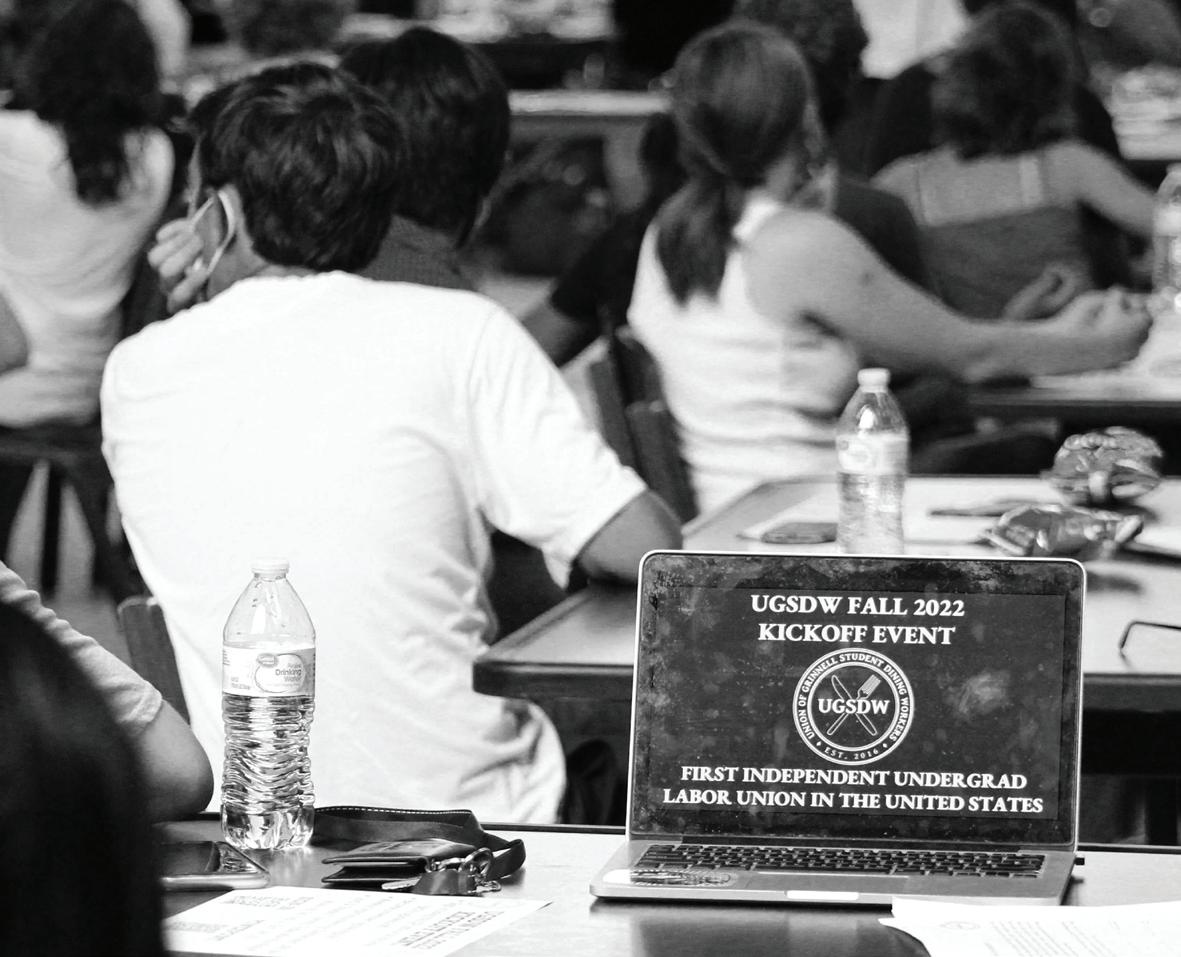
James Shropshire, the director of Campus Safety, disagreed with UGS DW’s position.
“This allegation is unfounded and untrue,” Shropshire wrote in an email to the S&B. “Campus Safety, as a matter of policy, does not under take surveillance of any member of the campus community or individu al location on campus.” Shropshire said that each building on campus is checked once per shift, and there are three shifts each day, but that no in tentional surveillance has taken place.
Looking towards bargaining
The Sept. 26 issue of Worker Power announced that the first bar gaining session will be held on Oct. 6.
“The bargaining team right now is working on drafting, editing, edit ing again, and editing again, propos als and finally finalizing them,” Galp ern-Levin said. “We are going to have a vote on the proposals, everything again. It's all about transparency.”
In addition, the current system of pay tiers takes away choice from low-income students, Gutman said. If all on-campus jobs paid more, students on work-study would not have to pick jobs based exclusively on wages. They could instead apply for positions that could help their resume, or that matched their career interests.
“I've heard from a lot of people who say they work in dining, but they would like to work as a grader or as a research assistant or, you know, may be work in the Bear because it's not as difficult to work in the Bear, but those jobs pay a lot less,” Gutman said.
According to the U.S. Citizenship and Immigration Services website, international students are limited in the types of jobs they can take due to the F-1 visa. While international stu dents can still take jobs off campus, they must relate in some way to their major of study. Therefore, many in ternational students rely on Grinnell campus jobs. Gutman said the wages off campus are typically higher than what the College pays.
“They're [Grinnell College] re lying on our work,” Gutman said. “They're not compensating us like they're relying on our work. And that hits the hardest for low-income stu dents, students on work-study and student workers who are using that money to pay for their living expens es.”
Gutman said that the Union is
“We're talking about an abso lutely absurd amount of money," said Galpern-Levin. "Point being, they have the financial resources to pay student workers much much more money, and they should.”
Workplace discrimination pro tections and real recourse
UGSDW’s other two bargaining priorities are recourse against work place discrimination and instituting “robust job protections,” according to the bargaining resolution and the third edition of the Worker Power newsletter.
The Union’s proposed solutions for issues of workplace harassment include mandatory nondiscrimination trainings and a grievance procedure that would be mediated by a currently unspecified neutral party. UGSDW has proposed that they “negotiate that independent process through the Union grievance procedure – provid ing Union representation for student workers and a neutral arbitration pro cess for addressing cases of harass ment and discrimination.”
In the Sept. 19 edition of the Worker Power newsletter, UGSDW advocated for changes to current procedures for addressing workplace harassment, citing current issues with the Title IX process at Grinnell as well as the discrimination that mail room workers organized to address in the fall of 2021.
Just Cause Employment and establishing Grinnell College as a sanctuary campus
Lastly, UGSDW’s final bargain ing priorities also establish Grinnell College as a sanctuary campus. Ac cording to UGSDW leadership, this will protect the campus from being raided by U.S. Immigration and Cus toms Enforcement (ICE) or a similar organization without a warrant. Gut man cited a 2016 ICE raid in Mar
Besides the UGSDW members who comprise the bargaining team, Galpern-Levin said UGSDW’s orga nizing team is also consulting with student workers to understand student workplace issues.
“Bargaining sessions are open to anybody who would like to attend,” Galpern-Levin said. “And we are go ing to encourage every single student worker on campus and every student who is able to come to those events
shalltown as part of the reasoning for this priority. In addition, Union leadership said that sanctuary campus status would protect all internation al students, not just undocumented workers.
“It's absolutely true that student workers of color and internation al students are in a more vulnerable position,” Galpern-Levin said. “And we believe that it's important, as rare or as common as these occurrences may be, that we, at least in the con tract, fight for there to be protections in place.”
This priority also addresses the presence of Campus Safety officers at
because it's important that we show the College that this is something that we care about, and that student work ers are paying attention to what the College says and paying attention to what the College is going to deny us as student workers.”
Editor's note: Isaiah Gutman is the Sports Editor. Gutman was not involved in the writing or editing of this article.
As student workers, all staff members of the S&B will be included in future collective bargaining. The S&B remains an independent news paper and is committed to maintain ing its integrity in reporting.
History takeover: Grinnell 14
By Ashley Baek baekashl@grinnell.eduIn November 1961, the U.S. faced the threat of nuclear war as tensions surrounding the arms race reached their peak. As the leaves on the trees began to turn into bright or anges and yellows, Grinnell students remained stubborn. They stood fast
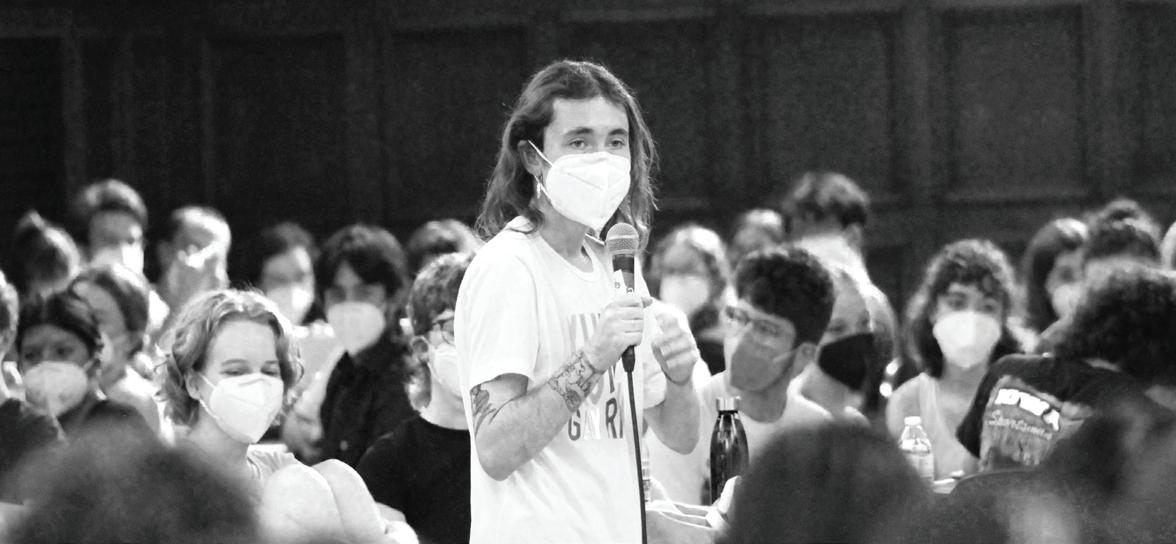
on their ideas of rationality and a commitment toward peace, support ing President John F. Kennedy's nu clear test ban and the “peace race,” wrote Peter Coyote `64 and Terry Bisson `64 for The Grinnell Maga zine in fall 2011. Fourteen Grinnel lians decided to take a public stance supporting Kennedy. They drove to Washington D.C. to protest the arms
race by fasting in front of the White House for three days, an event which is now known as the Grinnell 14.
According to Nancy Pogel in the November 17, 1961 edition of The Scarlet & Black, there was some ini tial confusion on campus about the stance of the Grinnell 14. The group did not register their fast as a pro test but rather as a show of support
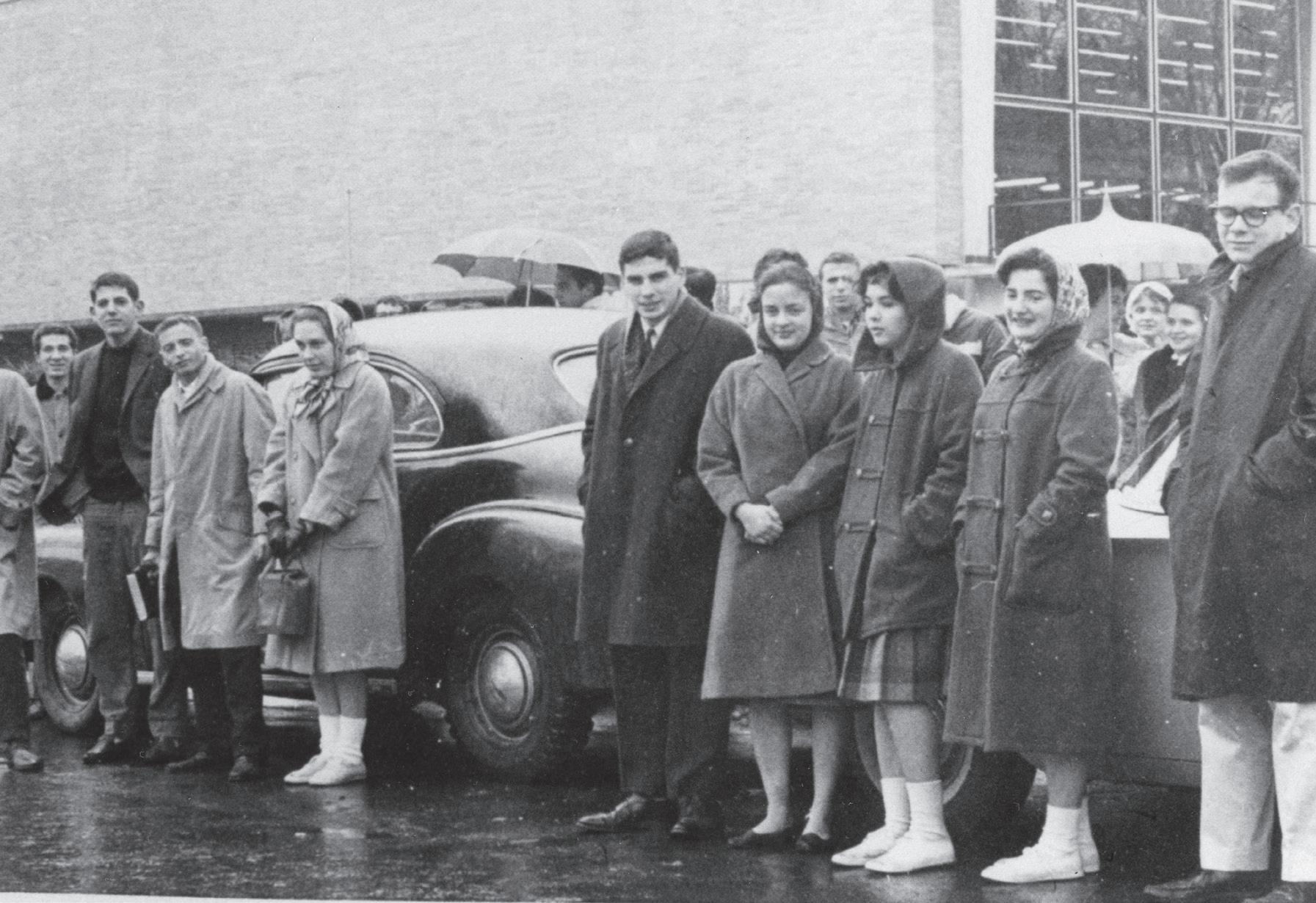
for presidential nuclear reluctance. While the 1961 Student Govern ment Association and the Grinnell College President, Horace Bowen, did not endorse the Grinnell 14’s efforts as their own political stance, they did permit the group to travel to Washington D.C., wrote the Grinnell Magazine.
The 14 Grinnellians received national attention as they fasted in front of the White House. They were met by the Associated Press and the United Press International, and they were eventually invited into the White House, where they met Kennedy's National Security Ad visor McGeorge Bundy. Bundy of fered them “orange juice and advice on how to conduct [themselves] as citizens,” according to the Grinnell Magazine. The Grinnell 14 refused and stayed true to their water-only diet.
Due to their White House invi tation, the Grinnell 14 were able to present to the Soviet ambassador, where The Washington Post showed up and took photos of this interac tion. They soon became internation al news.
While the Grinnell 14 was in D.C., Grinnell’s campus showed support by hosting a fast of their own. Over 280 students and 14 faculty members signed up for this “Sympathy Fast.” The fast began after lunch and continued until mid
night when students were finally able to drink water. In the Wash ington Bulletin and The Scarlet & Black, the authors urged the stu dents to help “demonstrate that stu dents are taking serious notice of the world beyond the campus.” Many Grinnell alumni additionally sent calls and well-wishes on their jour ney and mission when they heard of it, wrote Pogel.
As the Grinnell 14 gained more publicity, other college students found inspiration in their cause, ac cording to student bulletins and the Grinnell Magazine. Bluffton Col lege, in Ohio, sent a group of 15 to Washington, where the students fast ed from Saturday through Monday. Oberlin students also attended and Carleton College sent a group of 20 on the next Monday, fasting through Wednesday. As the Grinnell students left, they were met with caravans of students from other institutions tak ing their place in front of the White House. Students continued fasting for a year. According to the Wash ington Bulletin, the 14 Grinnellians lit the flame that fueled this peaceful movement.
Ultimately, this group of 14 Grinnellians made their mark on history by helping spark the 1960s student peace movement. They now represent Grinnell's commitment to social justice and demonstrate the passion that fuels Grinnellians.
Malcolm Galpern-Levin `24 UGSDW Executive Board
at LargeMADDI SHINALL Kelly Banfield `24 spoke at the USGDW general meeting. MADDI SHINALL Students at the first UGSDW general meeting on Sept. 11, when the Union announced their bargaining priorities. CONTRIBUTED BY GRINNELL COLLEGE LIBRARY ARCHIVES On a rainy November day in 1961, members of the Grinnell 14 paused for a moment outside Burling Library before starting their long drive to Washington, D.C.
Right to bear arms amendment on Iowa's Ballot
for the Iowa Constitution.
By Jandry Perez Garcia perezgar@grinnell.eduIowans eligible to vote will have an important decision to make on their ballot: on Nov. 8, they will be able to vote in favor or against a proposed amendment to the Iowa state constitution that states that the right to bear arms is a fundamental individual right that will not be infringed upon in Iowa, and that any and all restrictions on that right will be subjected to strict scrutiny.
In order for it to be added to the Iowa constitution, the proposed amendment needs to be approved by two consecutive general assemblies and ratified by a majority vote of public voters in Iowa.
In March of 2018, the amendment was passed in the Iowa Senate with a 34-15 and 54-42 in the Iowa House of Representatives.

However, the amendment process had to restart the following year, in 2019, due to an oversight from the office of the Iowa secretary of state. According to Ballotpedia, the oversight arose when Iowa Secretary of State Paul Pate, a Republican up for reelection this fall, failed to notify the Iowa Constitution of the amendments that the general assembly approved that year within the required time frame.
I really want to urge Grinnell students to register and vote in the coming midterm elections. As I said, this constitutional amendment is really a big deal in Iowa, and students are fully entitled by law to register here and have their say.
Janet Volk Former Iowa State RepresentativeJanet Carl, former Iowa state representative, said the addition of strict scrutiny is a big distinction between the language of the Second Amendment in the U.S. Bill of Rights and the one currently being proposed
Strict scrutiny is a legal term referring to the application of the concept of judicial review to determine a law’s constitutionality, according to the Legal Information Institute of Cornell Law School.
“I think people should not get this mixed up with thinking that a no vote means that a person is against the federal Second Amendment. I'm not talking about being against the right to bear arms. I'm talking about the second part of the amendment which is the level of judicial scrutiny,” Carl said.

[N]o constitutional amendment by its nature is a partisan deal. It's not put up by a particular party. It's not related to a particular party.
Janet VolkFormer Iowa State Representative
Carl said that she believes the discrepancy between what Iowans say they believe in, like what is reflected on the survey statistics, and the current legislation is potentially a result of people voting along party lines.
“[N]o constitutional amendment by its nature is a partisan deal. It's not put up by a particular party. It's not related to a particular party,” Carl said.
Carl also said she thinks that gun violence is a “public health problem” and mentioned statistics from the Everytown organization, which takes its data from the Centers for Disease Control and Prevention.
According to that data, Iowa experienced a 60% increase in homicides from 2019 to 2020; an average of 302 Iowans die by gun violence annually. Gun violence is the second highest cause of death for Iowa children, and 78% of gun deaths in Iowa are suicides.
“I really want to urge Grinnell students to register and vote in the coming midterm elections. As I said, this constitutional amendment is really a big deal in Iowa, and students are fully entitled by law to register here and have their say,” Carl said.
The Stella:
Affordable housing complex to be built in Grinnell
By Eleanor Corbin corbinel@grinnell.eduThe city of Grinnell recently approved a new low-income housing development called “The Stella,” which will be located south of Eighth Avenue and east of Bliss Street. The Stella, as well as several other low-income housing projects, was proposed after the 2020 Grinnell Housing Assessment, which noted a lack of affordable housing for residents in town.
This past June, an Illinois-based development company called North Star came to Grinnell to inquire about potential sites for the new housing development in Grinnell. Tyler Avis, Grinnell City director of building and planning, said he gave representatives at North Star a list of several potential properties around town.
Since June, the developers have selected a property, applied for lowincome housing grants and created initial designs for the eventual development.

The preliminary plans show 34 housing units in the new development, 30 of which will be low-income, in addition to a playground, a dog walking area and an area with grills and picnic benches.
Low-income housing units can be priced in a variety of ways. Some units are based on percentage of income, in that only those who make either 80%, 60% or 40% of median income of Grinnell can apply to lease a given unit. Other units accept Section 8 vouchers. Section 8 is a provision written by the U.S. Department of Housing and Urban Development that provides housing choice vouchers to low-income families, seniors and those with disabilities.
Susan Hiner, executive director of the Grinnell Housing Authority, said that she does not know whether The Stella plans to use Section 8 or create their own income base.
According to the Grinnell Herald-Register, the Iowa Finance Authority (IFA) has granted $980,441 in low-income housing tax credits to the project. They have additionally been awarded a one-time $500,000 grant from the U.S. Department of Housing and Urban Development as part of their HOME program, a grant program which distributes funds to state and local governments to increase homeownership and affordable housing.
Russ Behrens, Grinnell city manager, said that the city had a very little role in the planning or funding of this project beyond writing a letter of recommendation from the city to include in their applications for
funding.
“The idea is that they [North Star] build a product that is affordable and needed by the community,” said Behrens.
Behrens also listed some other low-income housing projects that the city was more involved in: the Spaulding Lofts apartments, located next to city hall, and The Row on Reed, located next to the hospital, are low-income housing projects pursued by the city. Both developments received Workforce Housing tax credits.
According to the 2020 Grinnell Housing Assessment, in which the city of Grinnell hired a firm called the Real Property Research Group to assess the current housing stock, Grinnell has room for improvement in terms of making housing affordable and available.
The idea is that they [North Star] build a product that is affordable and needed by the community.
Russ Behrens Grinnell City ManagerThe report describes Grinnell as “historically limited by a lack of quality housing units and higher land/ homeowner costs.”
It also notes that two-thirds of workers in Grinnell commute from outside of the city. Hiner said that
she recognizes the dearth of housing, particularly of two-bedroom units.
“For anyone needing to leave a current residence, whether it’s for domestic or divorce or just aging out of the home, there’s not enough housing for people to apply for,” Hiner said.
Behrens said that the recent focus on these new low-income developments “was a direct effort based on that housing assessment.”
In addition to The Stella, plans are in place to build a 48-unit development on Industrial Avenue south of Walmart. If all planned developments are built, the Housing Assessment projects a total of 52 surplus units, satisfying the estimated lack of affordable housing.
For anyone needing to leave a current residence, whether it’s for domestic or divorce or just aging out of the home, there’s not enough housing for people to apply for.
Susan Hiner Executive Director of the Grinnell Housing AuthorityAvis says that he expects to receive finalized architectural plans this fall or winter and for construction to begin in the spring or summer of 2023.
Community Calendar
Know your rights: Voting in Iowa
7:00 p.m. on Oct. 3 930 Park Street
Healthiest State Walk
1:00 p.m. on Oct. 5
Ahrens Park
Draconid Meteor Shower Watch
7:00 p.m. on Oct. 8
North Trailhead of Stagecoach
Piano Recital: Royce Wolf
11:00 a.m. on Oct. 11 1108 Park Street
Yoga in the Museum
12:15 a.m. on Oct. 11
Grinnell College Museum of Art
QUINGSHUOArts
"Reverent Ornament" spans nations, centuries
By Taylor Nunley nunleyta@grinnell.eduA small slice of West Asia and beyond has come to the Grinnell College Museum of Art this fall semester. "Reverent Ornament: Art from the Islamic World," comprising 45 different pieces, has worked its way across the country, and for a short period, it will have the chance to delight Grinnell students, faculty and visitors alike. The exhibition consists of what Assistant Professor of Art History Eiren Shea calls “portable arts” – this includes rugs, paintings and ceramic pieces.
Despite being such a small exhibition, the breadth of items on display is vast. “It looks like there are objects dating from the sixth century and also the 19th century. So, a huge range and huge geographic spread,” said Shea, who went to see the exhibition herself with a class on Tuesday morning.
"Reverent Ornament" itself is a smaller selection of pieces from a much larger collection. Drs. Joseph and Omayma Touma have amassed a personal collection of over 400 individual pieces over the course of the past 30 years. The Toumas, originally from Syria, donated a large portion of their collection to the Huntington Museum of Art, in Huntington, West Virginia, in the hopes of educating museum visitors
about their heritage, culture and the Near East — the transcontinental region in West Asia that was once known as the Fertile Crescent.
Now the Grinnell College Museum of Art hopes to achieve this same goal. Susan Baley, director of the Grinnell College Museum of Art, wrote in an email to the S&B, “We are especially mindful of the importance of hosting an exhibition of Islamic art at this moment, and we hope this exhibition will help visitors see similarities between cultures rather than differences.”
Displaying art from a nonEurocentric point of view has been an integral part of many museums’s recent attempts to help solve the dominance of Western art in what is considered “high culture.”
Yet, in a move that may be controversial to some, not every piece in the exhibition hails from the Near or Middle East despite its title. Shea relayed how one of the first pieces she was met with at the exhibition was made in Europe. “If you go to the exhibition, the first thing you see is a beautiful mosque lamp, but it's actually a vase made in 19th century France I think in imitation of a mosque lamp.”
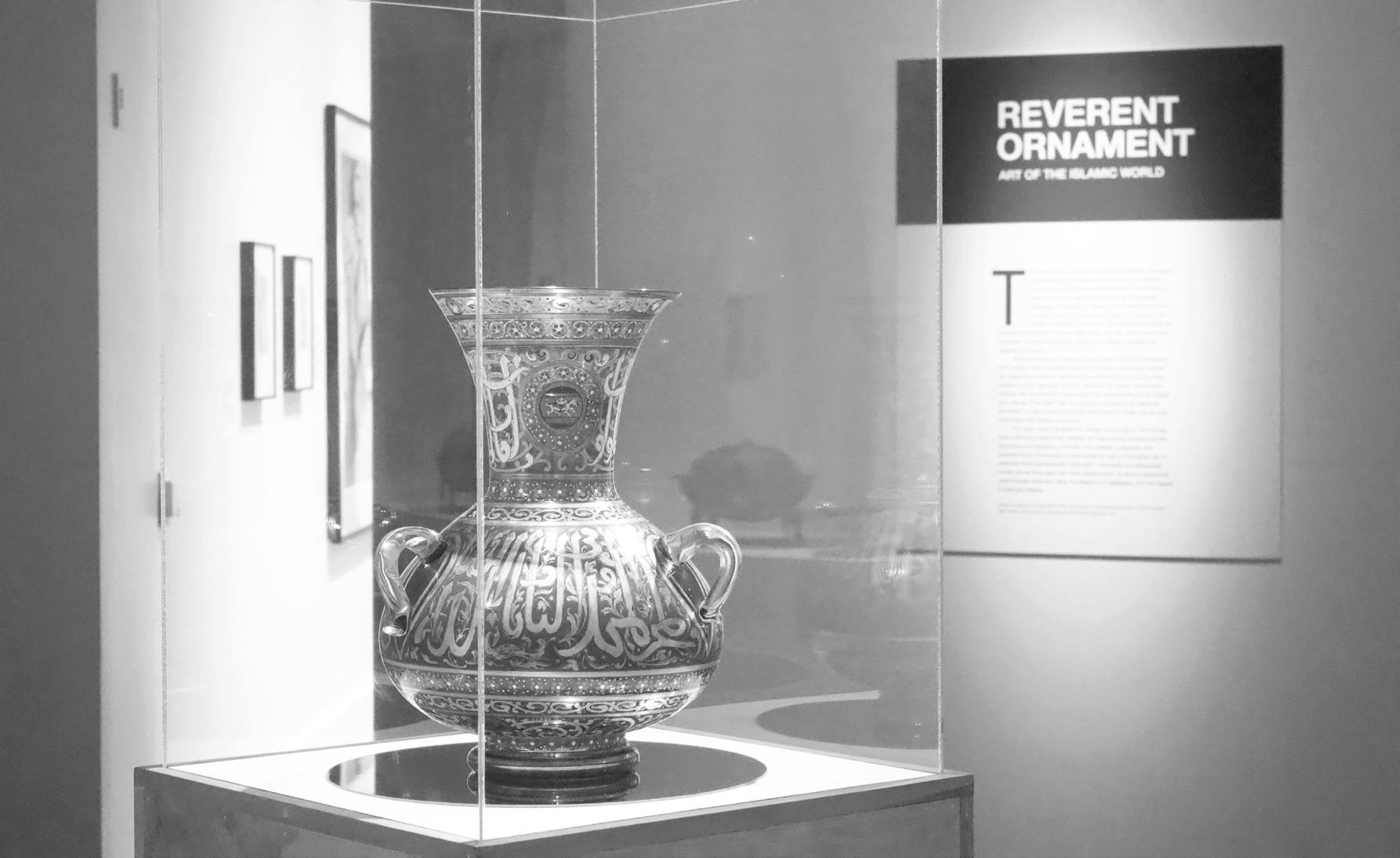
Shea also commented on the overarching grouping of all art made in the Near East as “Islamic Art.” “It'd be like if we called all Western art made in Europe before
1900 Christian art,” she said. Shea acknowledged that while religion has played an integral role in the art of the Near East throughout the centuries, this grave oversimplification of the true creative diversity of the area has problematically colored how it is often viewed in the West.
When asked about these issues, Baley wrote, “The purpose of the exhibition, as curated by Christopher Hatten of the Huntington [Museum of Art], is to explore ‘the West’s fascination with the arts and crafts
Knapp Center to host Film and Media Studies
By Daniel Stewart stewartd@grinnell.eduAfter years of preparation, Film and Media Studies is finally being offered as a concentration this Fall. Like all concentrations at Grinnell, the Film and Media Studies concentration emphasizes an interdisciplinary focus. Prospective students can expect to take classes in English, theater, and even computer science in conjunction with core film classes.
The program sets itself apart from other academic film programs not only with its interdisciplinary structure, but by stressing the importance of media production in curriculum while still being grounded in theory. However, the concentration still lacks a dedicated space on campus Chair of the Film and Media Studies and Assistant Professor of Spanish Nick Phillips stated that the administration has been supportive in launching the program. Nevertheless, it has been a challenge to find which space works best for students.
Courses, events, and related programming for students are currently split between the Humanities and Social Studies Center (HSSC) and Bucksbaum Center for the Arts. This has created myriad complications for students, such as lugging heavy audio-visual equipment from building to building.
There has been an ongoing conversation about which space Film and Media Studies should primarily occupy on campus: the HSSC, which would emphasize Film and Media Studies as a social study, or Bucksbaum, which would emphasize it as an artistic medium.
Phillips discussed some of the other constraints that came with not having a dedicated space to house the concentration. “Film and Media Studies does have some additional budgetary needs that other programs don’t have. It’s very expensive to run the equipment that is necessary, [which is] also very spatially sensitive.”
However, there is a space offcampus currently in reconstruction stages that will have the dedicated space needed for the concentration, a project expected to be finalized in 2025: The Knapp Film and Media Center, housed in a 100-year-old renovated auto garage. When the Center opens its doors, it will be the first academic building in downtown Grinnell.
The Knapp Film and Media Center was made possible by a leading gift commitment from alumnus Dick Knapp ’76. Knapp helped fund a number of other Grinnell College projects in town, notably including the Pioneer Bookstore. Knapp did not respond to our request for comment.
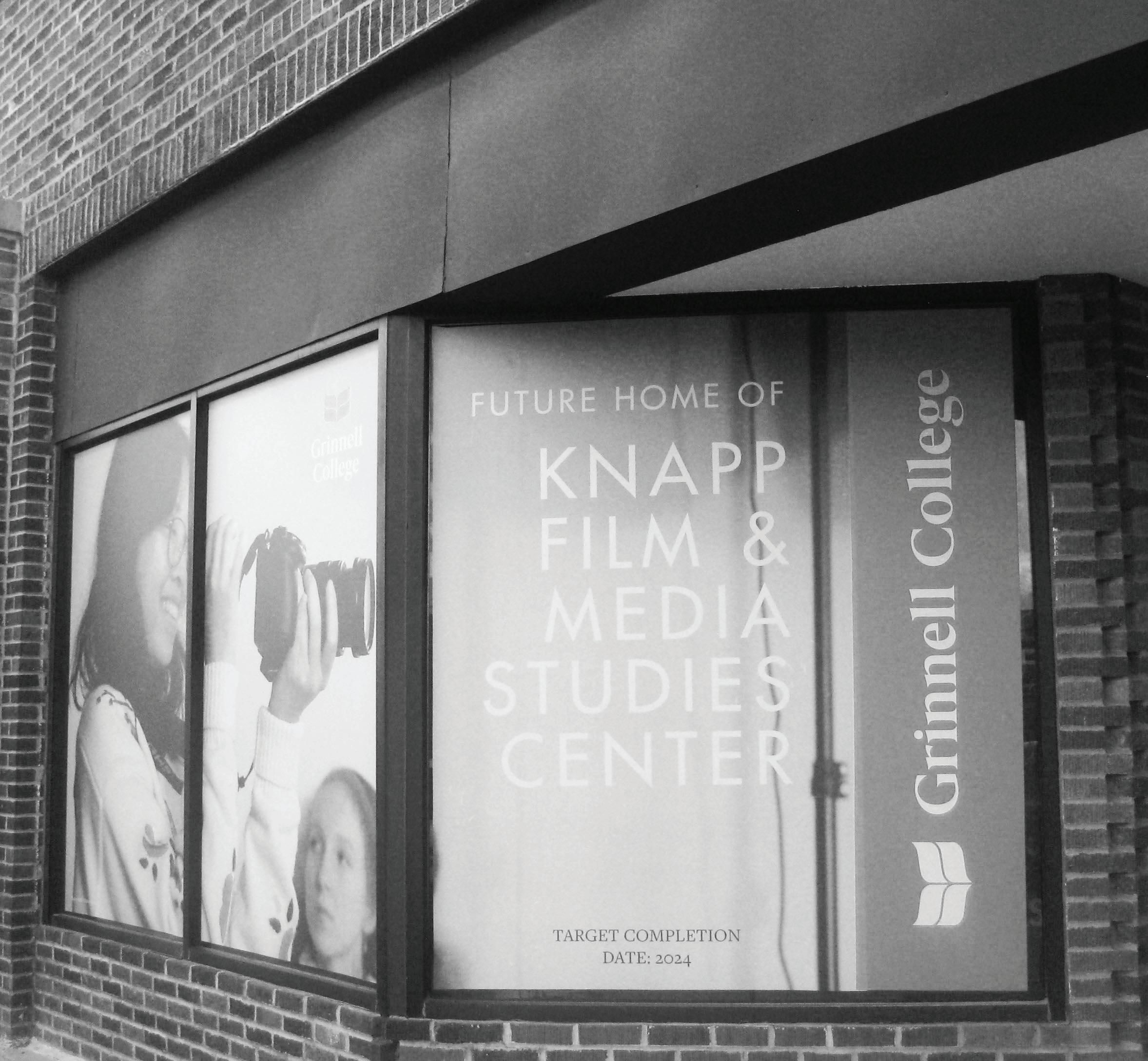
This project, and the concentration that it will house, are
representative of new directions for the College both infrastructurally and academically.
The new concentration provides opportunities that all students can benefit from. Recently, it co-sponsored a talk by Emmynominated documentary filmmaker Dawn Porter on campus. In addition to Porter’s presentation, she also sat in on some of Visiting Assistant Professor Nich Perez’s film classes, discussing her career in the discipline.
Perez joined the Film and Media Studies faculty this fall as a temporary replacement for Prof. Nicky Tavares, who is currently on sabbatical and is credited as laying much of the groundwork for the Film and Media Studies concentration. Perez expressed excitement about new opportunities students can participate in, including the potential for a student-run film festival this spring, and the new space downtown.
The town of Grinnell holds a wealth of opportunities for expansion. Phillips mentioned that he hopes the College continues to grow with the Knapp Center.
While it’s still a long process in the making, this new space would allow students to intentionally focus on their study of film while also being involved in community, linking the objectives of the concentration with the College’s emphasis on social responsibility.
traditions of the Middle East and beyond.’ Therefore, the exhibition includes work made by Western artists that reflect this interest in the Near East. The labels accompanying the works make it clear the objects are not Islamic art. However, the works refer to Islamic culture.”
Regardless of the pieces’s national origins, "Reverent Ornament" takes a large swath of history and showcases it in an accessible, digestible way. Visitors will be able to compare mediums from all different periods
and witness the crafts of Orientalist, or Western imitation, and Near East art alike. Through this exhibit, perhaps they will see just how similar the labor of creating and the labor of existing is across cultures.
"Reverent Ornament: Art from the Islamic World" opened in the Grinnell College Museum of Art on Thursday, Sept 29. It will run until Dec. 10 when it will depart to the Columbia Museum of Art in Columbia, South Carolina, and The Frick in Pittsburgh.
"Paper Trails" explores art in postcolonialist India
By Molly Wilcoxson wilcoxso2@grinnell.eduSudhir Patwardhan’s 2003 painting, titled “Wounds II,” shows a faceless figure contorting its body, writhing in pain, covered only by bandages. In her commentary on the piece, Tamara Sears, professor of art history at Rutgers University in New Brunswick, said that the figure “evokes a sense of deep suffering and excruciating pain.” “Wounds II” is one of the works featured in “Paper Trails,” a new exhibition at the Grinnell College Museum of Art.
have been shown at Grinnell – in 2017, Grinnell hosted “Many Visions, Many Versions,” an exhibition of art belonging to the couple by indigenous Indian artists.
“Paper Trails” features artworks created after India’s era of British colonization formally ended in 1947. Following independence, India began a period of partitioning which caused violence between various religious groups in South Asia. Many of the pieces featured in “Paper Trails” center around themes of religion and the friction it caused during this transitional time in Indian history.
“Wounds II,” according to Sears, tells a broader story of India during the 20th century– a tale of decolonization, famine, violence and oppression. “Paper Trails,” a collection showcasing over 90 contemporary Indian artworks created after the country declared independence in 1947, tackles these themes through the lens of modern art.
“Paper Trails” is the product of a collaboration between Sears and Grinnell Professor of Art History Michael Mackenzie. The exhibit’s current form is a second version of the original curated by Sears and her students in a graduate-level curatorial studies seminar at Rutgers.
After its initial showing, the exhibition was revised by faculty and students at both Rutgers and Grinnell.
Last semester, Mackenzie’s class at Grinnell, The Art of Decolonization: Modern and Contemporary Art of India and South Asia, analyzed several pieces included in “Paper Trails,” and they wrote texts to accompany the artworks, detailing their significance pertaining to Indian history.
Typically, the process of curating an exhibition can take years, but Sears and her graduate students created the initial draft of “Paper Trails” in three months. “For my students, it was not only a way to think through the parameters of an exhibition but also a process of learning content,” said Sears. “The exhibit really came out of pedagogy.”
All of the pieces in “Paper Trails” come from Umesh and Sunanda Gaur’s collection of contemporary Indian art. This is the second time that pieces from the Gaurs’ collection
During the curation process, both Sears and Mackenzie sought to represent contemporary Indian art in a world where, in their words, it is often overlooked in favor of Western modern art.
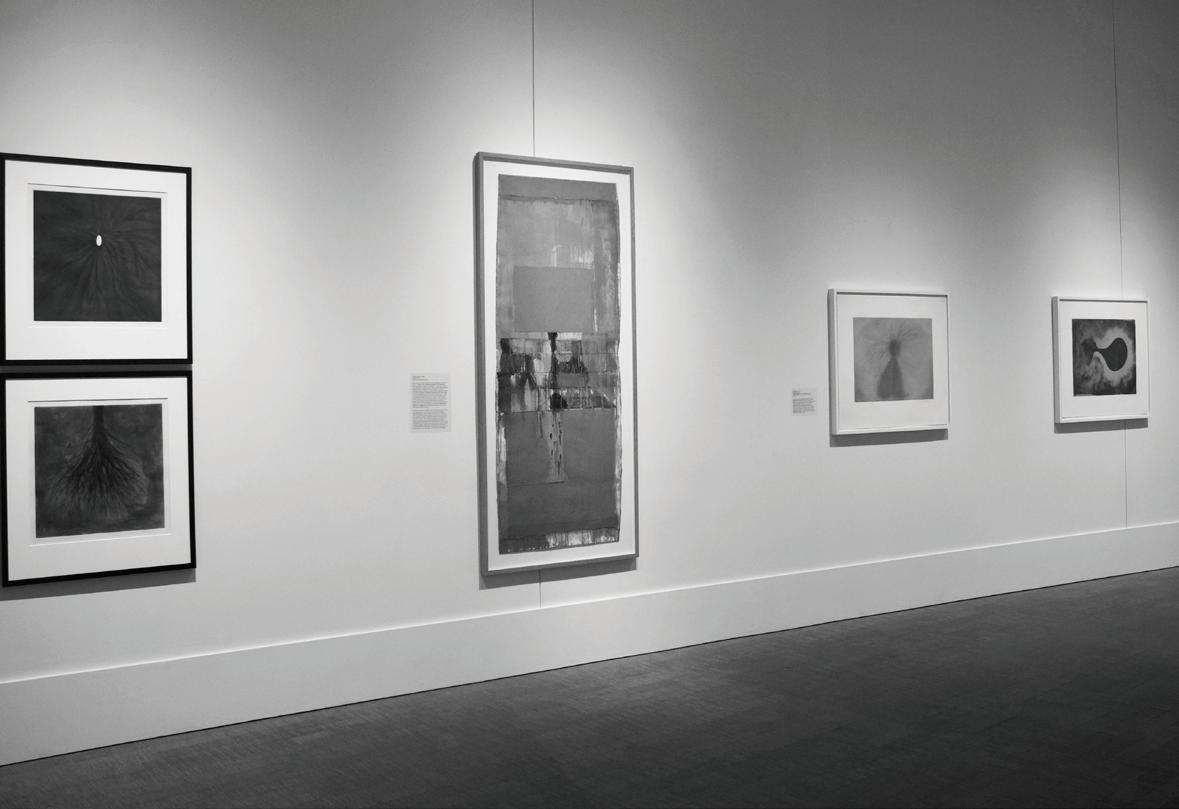
“Contemporary art in India and South Asia has its own rich and complex history,” said Mackenzie. “Though it's not completely detached from Western modernism, it is its own thing.”
Sears added, “The history of modernism in places like South Asia is often described as somehow coming only from engagement with the West, but we need to rethink that binary and instead see them as dynamic.”
Mackenzie said that he hopes “Paper Trails” can give South Asian students an opportunity to see their own cultures represented through the power of art as well as educate non-South Asian students on Asian artistic traditions.
“This is a great opportunity for us, whether we are part of the South Asian diaspora or not, to go together and talk to each other about cultural similarities and differences,” Mackenzie said.
“Art is made to be looked at together, art is made to be talked about. So, exhibitions are important because they're opportunities for us to go together and look at art together and talk about it,” said Mackenzie.
The College hosted an opening reception for “Paper Trails” last Friday with both Sears and Mackenzie in attendance. The exhibition is open to the public through Dec. 10, at Grinnell College’s Bucksbaum Center for the Arts, TueSat from 11 a.m.- 5:30 p.m..
OHANA SARVOTHAM "Reverent Ornament" showcases "portable arts," many of which are functional items such as glassware and rugs. OHANA SARVOTHAM "Paper Trails" showcases the diversity of contemporary Indian art.SportS

Mary Li and Parker Perry’s Player of the Week performances boost women’s golf to national rankings
guidance.”
By Cadence Chen chencade@grinnell.eduNearly two weeks before their last tournament of the fall 2022 sea son, the women’s golf team rose to number 22 in their Division III (D-III) national ranking. This follows their successes on Sept. 23, 2022 at the Na tional Collegiate Athletic Association (NCAA) D-III preview, regarded as one of the most prestigious D-III golf tournaments, at El Campeon Golf Course in Howey-in-the-Hills, Flor. They placed seventh out of 18 teams at the preview.
Mary Li `25 tied for fifth out of 94 individual players. She is currently the top performer on the team with an average score of 76.8. Because of her performance at the preview, the St. Louis Intercollegiate Athletic Con ference (SLIAC) named her Women’s Golf Player of the Week on Sept. 21.
Coach David Arseneault, Jr. said he believes her accuracy is what al lowed her to perform well this season. “While she might not be the longest hitter, her pinpoint accuracy doesn’t get her into trouble, and it leads to re ally consistent performances — espe cially on the more challenging cours es where accuracy is key,” he said.
One of the team captains, Lauren Chen `24, said that one of her goals for this season was to better the team culture, and she feels that “this is the
closest the team has ever been.” The team has made an effort to do activ ities outside of golf with one another, allowing them to get to know each other as individuals more deeply while also balancing having their own friends and lives.
The team has four captains this year: Aubrie Torhorst `23, Zoe Rob inson `23, Lexi Mueldener `23 and Chen. Last season, Nina Kouchi `22 was the team’s only captain, and her graduation “changed the look of the team,” said Arseneault. Kouchi was a two-time All-American and won three conferences.
“She is definitely the most ac complished golfer in our program’s history. Last year, a lot of the pressure was on her, and she was always bound to perform well,” said Chen, “but this year, we’re all taking on that responsi bility, where we all need to carry our weight a little more.”
According to team member Park er Perry `24, who was named SLI AC’s Golfer of the Week on Sept. 28 for placing 11th out of 82 golfers at St. Kate’s Fall Invite, having more team captains allows for more voices in the team to be represented.
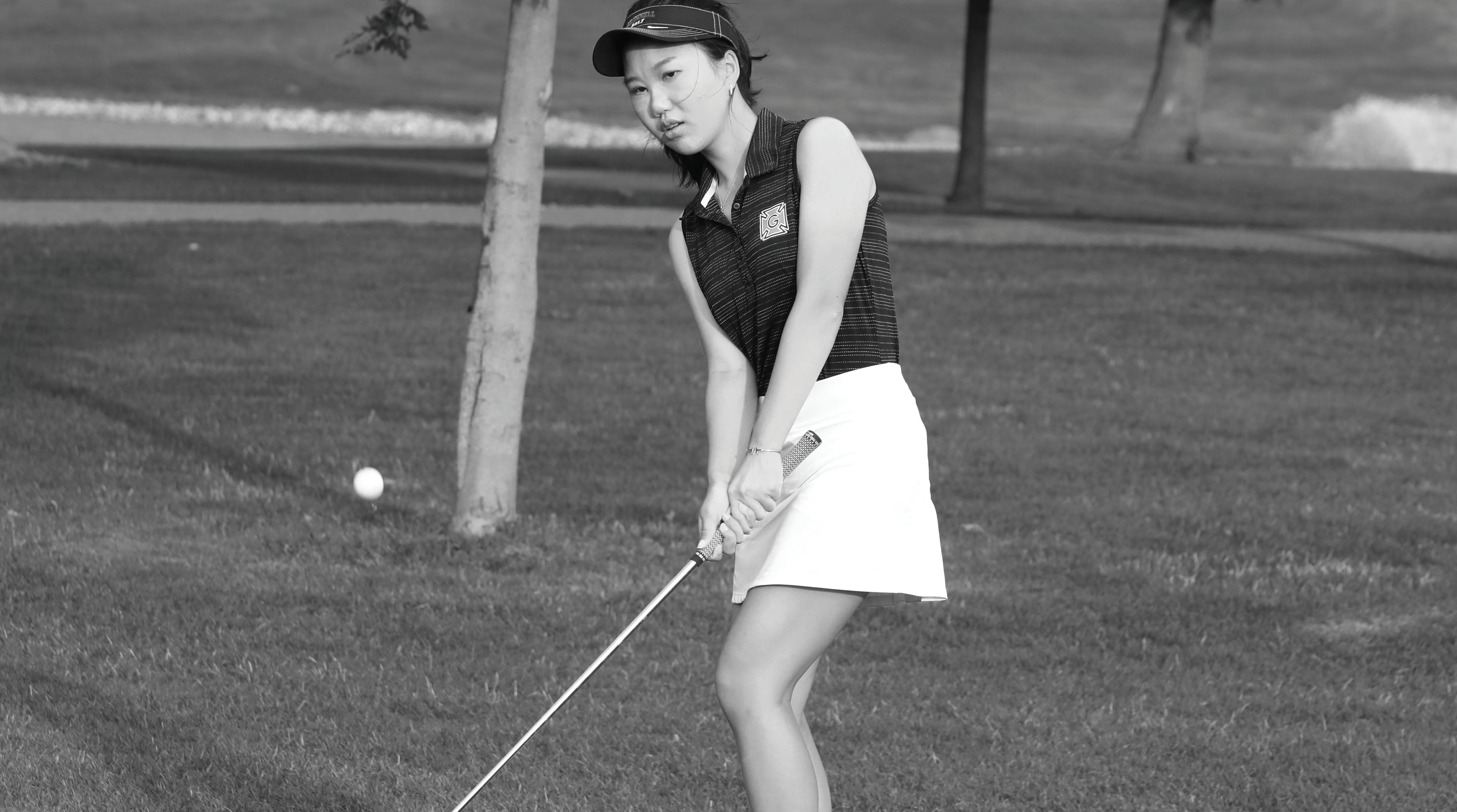
“I have so many role models to look up to and I’ve got so many supportive people to rely on and to confide in,” said Perry. “They’re a wonderful bundle of resources that I can definitely use for some help and
While Arseneault said there tends to be a varying number of captains each year, he said he believes that all of the people on the team demonstrate leadership qualities. He said that he believes they all rely on one another for expertise.
With four first-years joining the team and a total roster of 10 members, this is the biggest roster that the team has had in a while, according to the coach. In 2019-2022, there were five members on the team.
The weather has been a challenge this season, especially for the firstyears, according to Chen. Because all of the first-years are coming from international backgrounds, Chen said that the playing conditions may be different from what they are used to.
Chen also said that she has “not been feeling 100% for the last cou ple of weeks.” She said that, like her, some team members are recovering from illnesses, and others have sus tained injuries.
They officially began the season on Aug. 20, and they will close the season on Oct. 10 at the upcoming SLIAC Championship.
This year, the team will compete at the championship from Oct. 9-10 at The Rail Golf Course in Sherman, Ill. They will be competing to win their tenth consecutive championship.
The top five members will com pete for the team award, and four of their scores will count. The rest of the team will compete for individual titles.
In the time between the fall and spring season, which will begin in doors in March and transition out doors depending on the weather, the team is allowed to take a break and practice on their own time.
During spring break, the team tends to take a trip to somewhere with a warm climate. Last year, they went to Scottsdale, Ariz. and connected with a Grinnell alumnus who also par ticipated in athletics during his time at the College.
AC championship. During the spring season, he said that he finds that weather tends to be more unpredict able and not as nice compared to the fall season, making it “hard to plan.”
The high humidity in Florida’s D-III preview was a contrast from the cooler St. Kate’s tournament in Min nesota’s twin cities and the rainfall during the Wartburg Fall Invite.
Though Arseneault is unsure of what the team’s exact plans will be for the spring season, they will be depen dent on their performance at the SLI
While the team was unable to se cure a bid to attend the NCAA D-III Championship last spring, they re main hopeful for the next season.
Both Perry and Chen will be studying abroad during the spring season and therefore will be unable to compete.
Despite these potential hurdles, Chen agreed when Perry called the team “resilient.”
“We are going out there, and we’re going to compete,” said Perry. “Rainstorm, sunshine, great weather. We’re going to be out there.”
Grinnell Athletics Store opens; students skeptical of prices, selection
“I’m just glad none of them say Pioneers,” said Keir Hichens `22.5.
“It looks similar to bookstore merch. It is kinda expensive. I would probably not buy anything,” said Rowan Hutchinson `24. The pricing of certain items was an issue that several students, including Hutchin son, argued would make them not buy an item. For example, a pair of Nike fleece pants costs $56.99. The pants were a problem for other stu dents as well.
“I need pants but not from here. I don’t like the exclusivity that it’s online for only so long. It’s giving commercial vibes,” said Hayley Car son `25.
According to Cooprider, mer chandise on the website has been sold. “So far, we’ve had alumni, par ents, students and staff all purchase items through the store,” wrote Coo prider.
Not everyone was so critical of the store. Some students offered some constructive advice.
“It looks overpriced, but so is all college merch. I would probably buy a recruit hoodie,” said George Mat thes `25. This sentiment was echoed by other students who enjoyed some of the designs but did not enjoy the prices offered.
jerseys. I would buy that,” said Jacob Cowan `23. Cowan specifically men tioned that selling jerseys for sports such as basketball would make him more inclined to purchase merchan dise from the athletics department.
With the online store only ac cepting orders until Oct. 3, the stu dent body does not have much time to purchase items. Cooprider gave a reasoning to the timing, and he added that the store was requested by peo ple who want to support Grinnell in news ways.
By Conrad Dahm dahmconr@grinnell.eduThe Grinnell athletics depart ment recently opened a new online store accessible through their web site where individuals can purchase Grinnell athletics merchandise. The store is currently accepting orders through Oct. 3 and contains a wide variety of items ranging from t-shirts to hats.
In an email to the S&B, Ben Cooprider, associate athletic director, described the online store as a new department-wide move for athletics in the realm of merchandise sales. The setup for the online store was a collective effort.

“This summer we came to an agreement with BSN [Sports] who helped us launch this shop. They’ve been a vendor providing uniforms and apparel for a while now, and this is the first time we’ve done some thing department-wide like this,”
wrote Cooprider.
The department-wide effort is shown in the merchandise for sale: none of the items on sale mention any specific sport, but each says “Grinnell Athletics.” Cooprider also mentioned the conscious effort to avoid the usage of the word “Pio neers” on the shirt.
Cooprider wrote, “In 2019, at the direction of the Communications team, we underwent a rebranding process that looked at font, logo, style, etc. and the designs depicted in the team store align with the athletics brand guidelines developed during that process.”
Many students have called for the College to drop the Pioneers nickname — including a petition cir culated by alumni in 2020.
The S&B asked several Grinnell College students in Spencer Grill their opinion of the online store. Multiple students were not very sup portive of the store.
“It’s really expensive. If I wanted to buy merch I would go to the book store,” said Marisa Goffman `24.
Other students offered the athlet ics department some design ideas for merchandise that they think students might be more likely to buy.
“I would recommend them to sell
“[It] was a matter of the timing of the beginning of the academic and athletic year, and aligning with families, alumni and friends all po tentially desiring some new apparel to represent Grinnell College and our athletic teams,” Cooprider wrote.
CONTRIBUTED BY TED SCHULTZ Mary Li `25 competes for the women’s golf team. Li was named the SLIAC player of the week for Sept. 21.It’s really cool to be part of a tradition where the fans are so intensely supportive and into it, and just by virtue of your school.
This year, we’re all taking on that responsibility, where we all need to carry our weight a little more.
Lauren Chen `24
I have so many role models to look up to and I’ve got so many supportive people to rely on and to confide in. They’re a wonderful bundle of resources that I can definitely use for some help and guidance.Parker Perry `25
OpiniOns
No such thing as not disabled enough
By Emmy Potter potterem@grinnell.eduI have never been the picture of health. From a young age, I struggled with feeling fatigued, weak, achy and dizzy. I was passed from provider to provider because something wasn’t quite right. At first, doctors suggested it was just growing pains, yet my symptoms persisted and eventually worsened. I lost weight, I lost energy and eventually I lost interest in the things I enjoyed. Classes, activities and even friendships became a chore.
After searching for answers for almost a decade, in my junior year of high school I was diagnosed with dysautonomia, a broad term encompassing over 15 specific con ditions that affect the body’s ability to regulate its involuntary responses, like heart rate, blood pressure, body temperature and digestion. Patients may experience fainting spells, diges tive tract paralysis, heart problems, fatigue and migraines. Dysautono mia can make it hard to walk a few hundred feet.
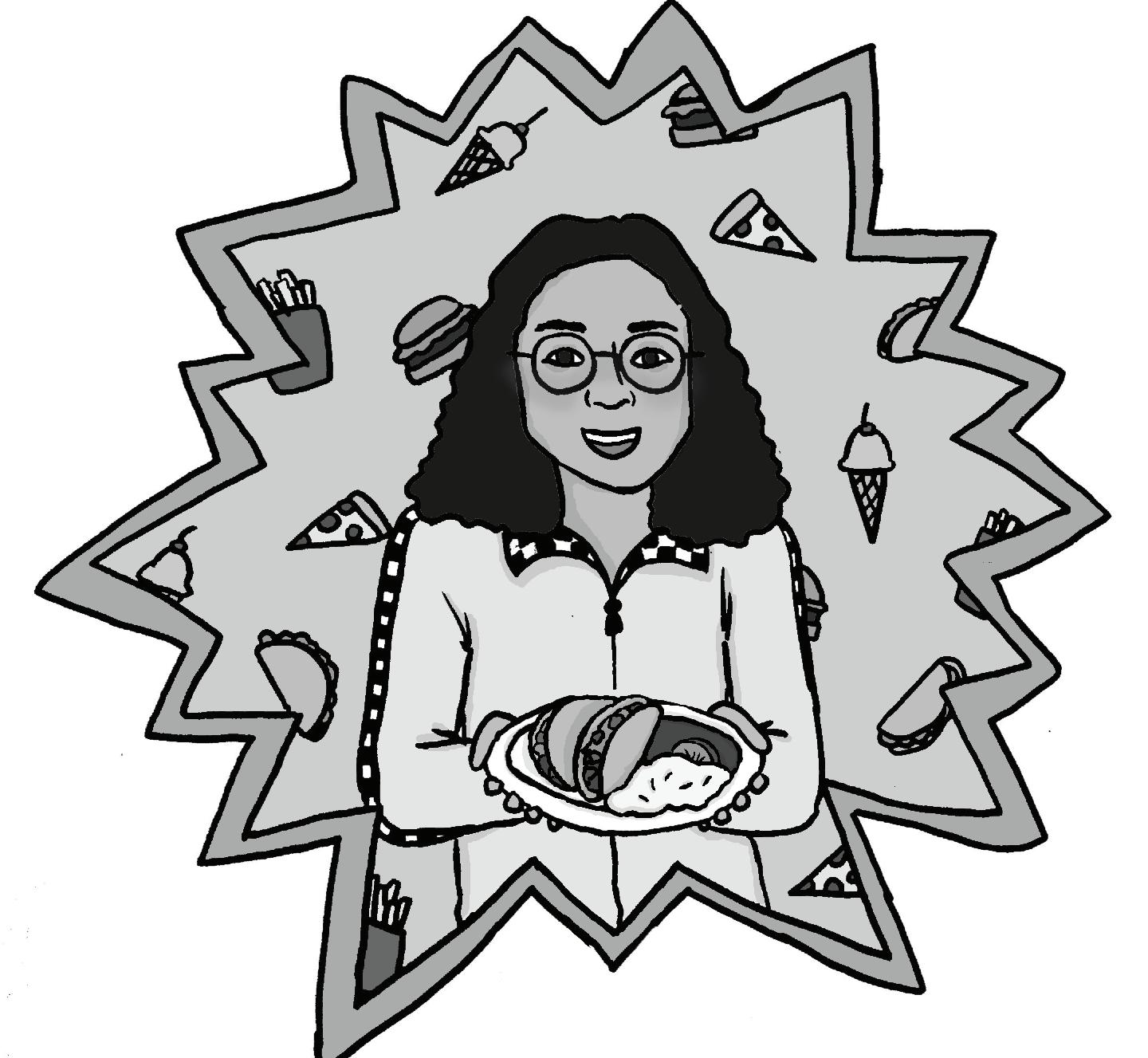
Despite being a disabling condition, its symptoms are often not apparent, leading to the assump tion that patients exaggerate or fake symptoms. I consistently found that teachers, peers, community members and even medical professionals just did not understand. People told me it was all in my head more often than they offered to help manage my symptoms or improve my quality of life. It took me nearly a year to get a steady 504 plan, partially because it was a rarity at my high school but also because my teachers and admin istrators couldn’t quite comprehend the need for one because I didn’t fit their conception of someone with a disability.
Much of the discrimination that I faced didn’t come from malfeasance but rather a lack of education. I can understand this because I too used to think the same way. Prior to develop ing my own, I thought of disability as mobility aids, hearing aids and other things that indicate visible physical impairments, but those only account
By Gabby Hernandez hernande6@grinnell.edufor a very small percentage of disabil ities. The exclusion of non-apparent disabilities, including mental illnesses and other chronic illnesses, perpet uates the stereotype that disabilities have to be visible and discredits the experience of many people living with various types of disabilities.
Realizing that my experience didn’t stem from intentional discrim ination, but rather misconceptions, made me want to educate people
tion because they didn’t feel like they were disabled enough.
One of the most integral parts of embracing my disability was seeing other patient advocates share their stories. Through these communities, I finally found somewhere I belonged and people that genuinely understood me. My experiences qualify me to speak on the topic, and there’s no such thing as not being disabled enough.
thought they were missing some thing, emphasizing my symptoms and asserting that I knew my body better than they did. While this didn’t always bear the results I wanted, it made me feel just slightly more in control of my health and proved, above all, that I do know what’s best for myself.
Grinnell is a very different atmosphere than rural Nebraska, where I grew up: people here tend to be much more educated on issues in volving different identities, disability included. I feel that it’s never been difficult to have conversations around accessibility, stereotypes and other key issues that affect the disabled community. This increased willing ness to learn about, understand and accommodate various backgrounds and lived experiences has brought me a sense of comfort and allowed me to be more open regarding my social and academic needs. Accommoda tions are far more common here than they were in my high school, and Disability Services makes the process of navigating academics much easier.
and share my personal experience. However, I felt it was too much to take on by myself. Additionally, I internalized stereotypes about what disability should look like and ques tioned whether I was even qualified to speak on the topic. I found myself disabled by my condition and craved support from people who understood what I was experiencing, but I felt like I wasn’t disabled enough and didn’t truly belong in the disabled community. After struggling for years with my identity, I realized that I deserve the same amount of support and respect as any other disabled or able-bodied person, and I wish that I had someone to teach me that sooner.
I realized that I needed to speak up because not being believed or taken seriously was emotionally exhausting, and I didn’t want anyone else to have to live with that exhaus
Advocacy is usually thought of as large-scale projects like sharing stories and gaining publicity for an issue to initiate systemic change, but advocacy work doesn’t always have to be big or flashy. I think of advo cacy as authenticity: openly sharing your story and the values that stem from it, and not being afraid to start hard conversations with peers, pro viders or other community members.
While I participate in advocacy on the local, state and federal levels, speaking up for myself and initiating conversations in my personal life has impacted me the most. For me, this mostly took place with providers, teachers and peers. Advocacy in the exam room created the most tangible change: receiving better care. After gaining the courage from support groups and patient advocates, I decid ed to tell health care providers when I
In my experience at Grinnell, accommodations are much easier to attain and people are much more receptive to social issues regarding disabilities, but there are still things that need to be considered on campus regarding health and wellness. When my health started to decline during the 2022 spring semester, I needed a series of appointments in Iowa City.
For the several months that I was struggling, I felt as if I was drowning trying to coordinate appointments and procedures, take care of myself, keep up with my school work and maintain my social life. It was too much to juggle.
Following my first real expe rience trying to manage my health and academic load on campus, I realized how unattainable care is. You constantly have to choose between prioritizing your health, succeeding in your classes and having a life out side of school. Transportation to ap pointments is expensive, and despite having a hospital in town, specialty appointments require you to drive to
either Des Moines or Iowa City. I’ve shifted my priorities because I don’t think that students should ever have to put their health on the back burner, and I don’t think that disabled stu dents should be forced to fall behind or sacrifice their mental health to take care of themselves.
This month is Dysautonomia Awareness Month, one of the aware ness campaigns nearest to my heart. It is particularly pertinent consider ing that around two-thirds of long COVID-19 patients develop Dysau tonomia. In my work moderating support groups for Dysautonomia In ternational, I have found the support groups flooded with long COVID pa tients. While the statistics aren’t clear, a recent CDC analysis suggests that around one in five people infected with COVID-19 will experience long COVID symptoms, which equates to almost 20 million people in the U.S. alone. These patients don’t have clear treatment regimens, many struggle to maintain the life they had before COVID and to make matters worse, they don’t qualify for disability ben efits. While some interventions have been attempted, most notably Senator Tim Kaine’s attempted long COVID bill, nothing has been done yet, and millions of people are falling through the cracks of the U.S. healthcare system.
There’s a lot more advocacy to be done to continue to make sure that patients are being taken seriously, make a space for patients to share their stories and ultimately ensure that patients are able to receive support and an invaluable sense of community during a difficult time. Since the pandemic, addressing serious concerns about healthcare has entered the national dialogue, but I still believe that there is more work that needs to be done. While we can’t individually reform the healthcare system, we can take control of our own health by prioritizing caring for ourselves and giving our bodies the respect they deserve. My experience has taught me to always advocate for myself and my needs, and I hope it can help you do the same.
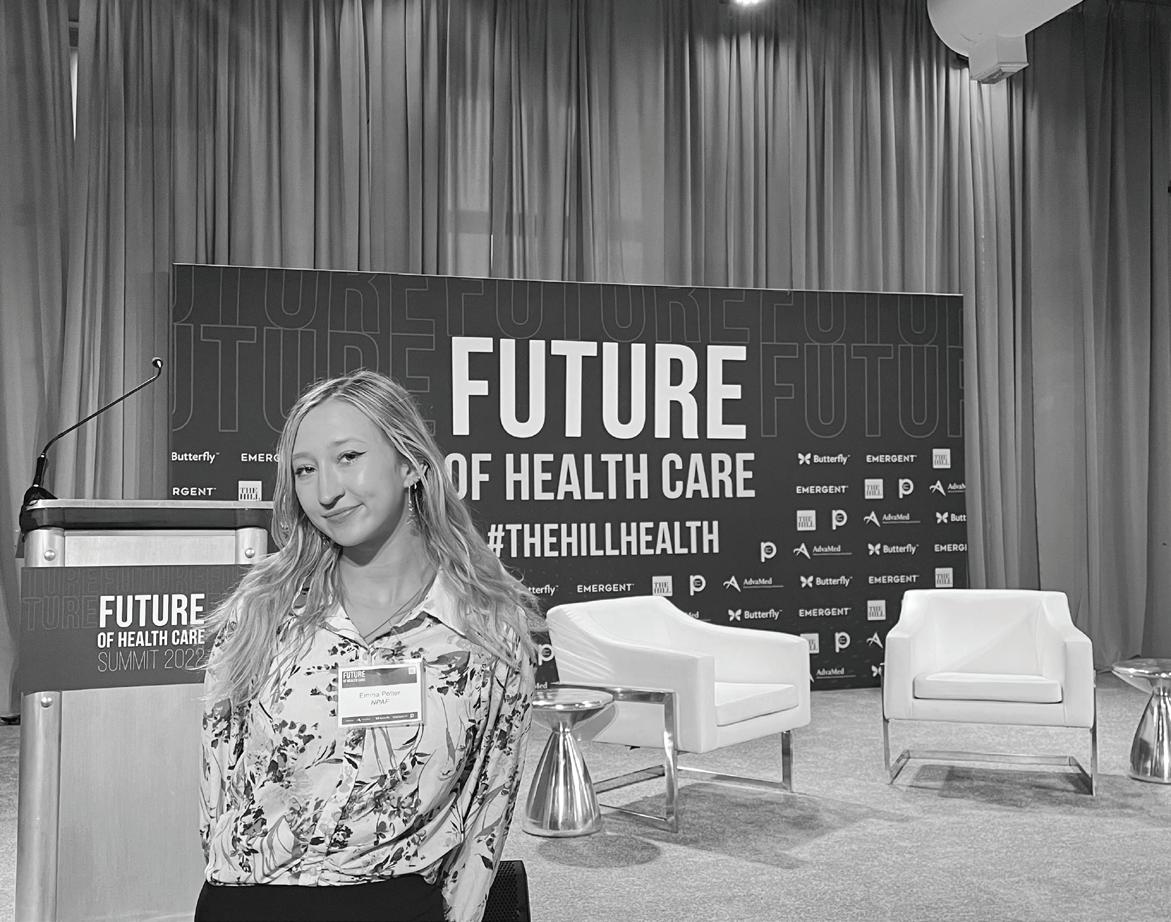
Food For Thought: Flavor of the Month
I developed the most villainous caffeine dependency since returning to Grinnell. I cannot reach my peak of productivity without a shot. This is in part because of my roommate’s espresso machine; that espresso always tastes like divine adrenaline, but sometimes I just need a coffee from Saints Rest to power up slowly and flavorfully.
I have been a fan of the concept of a flavor of the month since Dairy Queen began producing s’mores blizzards. With the end of September and thus the end of Saints’ signature flavor of the month, salted caramel, I come to you with my verdict on the special beverages at Saints. My evaluation of each will be so thickly described that you will be able to imagine how they tasted if you missed the chance to try them!
The Salted Nutroll is far superior to its rival, the Starbucks salted caramel frappuccino, in texture. When drinking Starbucks frappuc cinos, I have found that my mouth is frequently left with a lingering coffee texture profoundly similar to the ugly gray slush found on car windows during cold weather, the kind of texture that is characteristic of unremarkable coffee. The Salted Nu troll instead has a smooth and creamy texture similar to that of an iced chai from the Grill.
If you wish to imagine the flavor of the Salted Nutroll, I encourage you to imagine the smooth texture and campfire-esque essence of a
gently used Scrabble tile condensed into an iced beverage. This beverage is perfect for maintaining a positive mindset while working in Burling Li brary, and if you are not wearing your favorite autumn sweater as you sip on
specialty beverage, I was warned not to stir it. This warning, the drink’s appearance and its flavor all caught me by surprise. It was snow white in color with whipped cream to top it off. It felt like the first intense autumn
ized that Saints’ Salted Cream Soda was essentially a cream soda float that I could consume without facing the digestional distress that accompanies dairy.
The Salted Cream Soda is the per fect drink for creating a to-do list for the week. I should warn you that this drink is not suited for those who think a cream soda float is too sweet, as the primary flavor of it is simply sweet.
The Salted Cold Brew was quite the underdog out of the list of specialty beverages. I usually prefer unbridled sweetness like that of the Salted Cream Soda, but the thin and crispy texture of this cold brew made my tastebuds crackle with the same joy as a campfire receiving fresh wood. My first sip was remarkably light, and I met the same pleasant and flavorful surprise as the first time I tried coffee-flavored ice cream.
specialty beverage can be consumed in a hot or cold form, though the cold one is far more satisfying with respect to caffeine content, splendid flavor and raw positivity. I could not stop drinking it after I took my first sip. The Salty Turtle has the perfect balance of all-consuming sweetness and productive caffeine content, such that shortly after chugging half of it in one breath I was bouncing off the walls of Saints and plowing through my assigned reading. In my fervor, I splattered countless drops of coffee on my pages.
this lightly chilled beverage, you are doing it wrong. The only downside is that it does not come with whipped cream and caramel-flavored syrup.
The Salted Nutroll is significantly less sweet than two of the other special beverages for September, so if your sweet tooth is not the most demand ing, this drink is for you!
When I was handed my Salt ed Cream Soda, a non-caffeinated
Nadia Langley Allison Moore
Mohammad Igbaria
Nick El Hajj
Lucia Cheng Lilli Morrish
Isaiah Gutman
Nina Baker Millie Peck
Samuel Bates Emme Perencevich
Maddi Shinall
Cornelia Di Gioia
Qingshuo Du Alina Ihnatesku Nina in memorium
breeze: there to warn you of the im pending winter months.
With my first sip of the Salted Cream Soda, I was met with a star tling sweetness that I could not put my finger on. It was not sweet in the way of candy or syrup; the soda possessed a primordial sweetness that surpassed even warm gooey butter cake with a scoop of vanilla ice cream on top. Halfway through chugging it, I real
SPARC Policy
The best way to describe the Salted Cold Brew is as Gold Peak Iced Tea with a hint of coffee. Its smooth fluidity flowed through me more naturally than water. In this cold brew, I was able to catch a glimpse of what the nectar of the gods must taste like. As far as its appearance is concerned, the Salted Cold Brew is a beautifully transparent brown only slightly darker than whiskey. This beverage made me feel as though I could plow through seven biochem labs back-to-back (even though I have not taken a lab science since my first semester at Grinnell).
Ultimately though, I will always remember Saints as the place I met my true love: the Salty Turtle. This
If you want to imagine the flavor of the Salted Nutroll, I encour age you to imagine the smooth texture and campfire-esque essence of a gently used Scrab ble tile condensed into and iced beverage.
When I imagine the flavor of the Salty Turtle, I cannot help but assign the same satisfaction to it as I would to biting into your favorite scented candle, assuming there would be no negative consequences from heat or wax. My cup was overflowing with flavor, and the only thing I longed for was a larger cup. The Salty Turtle is far more flavorful than the Salted Cold Brew and Salted Nutroll and is much more manageable in sweetness than the Salted Cream Soda. This is the drink to watch out for next time Saints’ flavor of the month is Salted Caramel.
The Scarlet & Black is published on Mondays by students of Grinnell College and is printed by Times Republican of Marshalltown.
The newspaper is funded in part by the Student Publications and Radio Committee (SPARC) and also relies on advertising revenue to cover operating costs. All publications funded by SPARC are copyright of SPARC and cannot be reproduced elsewhere without specific written consent from SPARC.
Contributions
The Scarlet & Black welcomes story ideas from students, faculty and other members of the town and college community. If there is any story that should be covered, please email newspapr@grinnell.edu or visit thesandb.com
Send letters to the editor via email at newspapr@grinnell.edu or mail them to Box 5886. The author’s name must be included, but letters can be published anonymously in certain occasions. Letters will be printed at the discretion of the editor. The opinions expressed in this section do not necessarily reflect those of the editorial staff. The S&B reserves the right to edit any and all submissions.
HANNAH AGPOON CONTRIBUTED BY EMMY POTTER Emmy Potter doing advocacy work at a health summit in DC this summerBackTpage
Sage & Blunt Advice:Fatigued Friend

Dear Sage & Blunt, I consider myself quite a social person, however having one-onone hangouts with my friends is where I thrive. I recently had an experience with a friend that left me a little upset. We had made plans without a real activity in mind, and I made the assumption that it would be a quiet night in. It quickly became apparent that they wanted to pregame for an upcoming party. I’m always down for a spontaneous change of plans, but they didn’t talk to me to even gauge if that was what I wanted. Even worse, they seemed to want my approval for going out. I didn’t want to be a buzzkill, but at the same time, I just wanted to spend time with my friend. I know a conversation is probably needed here, but what are some ways I might soften the blow?
Sincerely, Fatigued Friend
Dear Fatigued Friend,
I like you! You’ve already done half my job for me and given yourself a little advice at the end of your letter. I agree with you, this can be talked out. You clearly value the time you spend with this person and they care about earning your respect. If I were you, I would set up a date with them and plan your ideal night in. Cook them a meal! Give each other hair cuts or just watch a movie — whatever fills your cup (and hopefully theirs) with the kind of joy you get from quality one-on-one time. It’s nice to remember why you like being in each other’s lives, and it will make the conversation easier.
I think you can also soften the blow by own ing the fact that you set an expectation for the night that
The best thing since the front page!
your friend wasn’t aware of. To be fair, they had no way of knowing that you were looking forward to a different kind of hang than they were. Chalk it up to a good old-fashioned misun derstanding, and then as sure them that you’ll make it clear what kind of time you’re trying to have when you make plans in the future, then actually do what you say: communicate. This sounds like the kind of per son who would want to know if they had upset you, and it’s hard to imagine anyone responding negatively to the feedback that their friends want to spend more time with them. I hope they take it well, and I wish you both many more nights of clearly communicated, planned fun.
Signed, Sage & BluntWhat Each Sign Tweets at 3 a.m.
Libra (Sept. 23 - Oct. 22)
every single washing machine in main is full and that’s so fine but can someone let me know when there’s an empty one? I wish there was a system to tell me when the machines were open
Scorpio (Oct. 23 - Nov. 21)

i’m going to start a rumor that I saw a bat flying around in d-hall
Sagittarius (Nov. 22 - Dec. 21)
when is my ex getting back to cam pus, i need to talk to a gemini
Capricorn (Dec. 22 - Jan. 19)
last time i looked at a clock it said 10 a.m. then i drank two red bulls and three five-hour energies and i’ve been blacked out since then but my paper seems to be finished, so i’ll be doing this again next week
Aquarius (Jan. 20 - Feb. 18)
poll: would you guys rather ride a magical unicorn that poops ice cream or have a cat that can fly for the rest of your life?

Like what you see?
check us out:

@thesandb
/thescarletandblack
thesandb.com
@grinnellsandb
Pisces (Feb. 19 - Mar. 20)
the person who sits next to me in literary analysis got a 69 on their paper and i’m just such an empath i felt my own grade dropping (al though it didn’t really — I got a 92)
Aries (Mar. 21 - Apr. 19)
had to call campo to rescue me off the bucksbaum roof tonight. we’ve all been there
Taurus (Apr. 20 - May 20)
when i ship something to grinnell, they should just ship it straight to burling because at this point in the semester i literally live there
Horoscopes: Communication is Key
By Ms Constellation PrizeLibra season is far from over, and it’s the perfect time to practice our communication skills. Libras are terrified of confrontation, so it’s important to be proactive and not fall into this vicious cycle of peo ple-pleasing. This is a perfect excuse to download a new social media platform where you can be unapolo getically yourself.
Twitter is the perfect place to share your controversial takes, academic opinions and meaningless streams of consciousness, especially now that YikYak is essentially over. And Grin nell Twitter? Even better. Tweeting with your peers is a fun way to dish
Gemini (May 21 - June 20) as long as i have one friend who works in the grill, i’ll never have to pay for my iced chais with almond milk or strawberry/mango smooth ies again
Cancer (June 21 - July 22) can anyone drive me home this week end? i need to go visit my pets
about the intra-campus drama in a casual way.
Imagine a place where you can fol low celebrities, politicians and peers. Through my interaction with Grinnell Twitter, I’ve gotten advice, made close friends and had two dates. It’s a bottomless pit where I’ve made some seemingly random but meaningful connections.
So go out this month, party hard and find a way to connect with people, whether that be in real life or online. A good way to keep in touch with casual acquaintances or even blow off some steam is to send some rambling texts at 3 a.m.
Leo (July 23 - Aug. 22)
i’m going to do a stand-up set at bobs open mic this week (i’ve never per formed before and am fully prepared to bomb but that’s the beauty of live theater)
Virgo (Aug. 23 - Sept. 22)
*No tweet for Virgos: they’ve never stayed up past 1 a.m. When the Har ris ends, so does their night.
he Have questions regarding sex, sexual health, sexuality, gender, relationships and the pro motion of respect at Grinnell College? Check out our column On the Same Paige: sex planations and other equity tips. An anon ymous q&a column run by Title IX postbac Paige Olowu! Use the QR code to submit any questions you have.


Rants & Raves:
Students & community members speak about what’s on theirminds in 75 words or fewer, and you’re invited! If you have a rantor a rave, email it to [peckcami].
The HSSC fire alarm was the best thing that’s hap pend to me since getting to Grinnell.
- Still hungover in class
Why do I see the one person I’m trying to avoid seventeen time a day?
- hookup gone wrong
I wonder what the Grin nell arsonist is up to these days...
-rose hall trashcan
Feeling like you too could use some advice? Contact Sage and Blunt using this QR code!
